Physical Address
304 North Cardinal St.
Dorchester Center, MA 02124
Acknowledgments: The authors gratefully acknowledge the very broad shoulders of the giants who have preceded us in writing this chapter, including Drs. David Green, Marc Garcia-Elias, William Geissler, and most recently Alberto Lluch. In particular, Marc Garcia-Elias, through his astute clinical observations, masterful theoretical reasoning, detailed drawings, and landmark research, has so eloquently unwound the mysteries of the carpus in these pages over the last 16 years. These are footsteps that are impossible to fill but which provide us with an indelible path forward.
The eight carpal bones that comprise the wrist joint represent the most complex articular system in the human body—each capable of moving in different degrees or directions dependent on the position, motion, and force generation of the hand in space. The human wrist is a magnificent engineering mechanism that allows precise positioning of the hand and optimization of power and prehensile tasks throughout a nearly hemispherical arc of wrist motion. Injuries to this finely tuned mechanism can lead to instability, resulting in a painful lack of motion, strength, and function. A broad understanding of its anatomy and mechanics is critical to treating its dysfunction. The literature is replete with hundreds, if not thousands, of carefully crafted investigations, astute observations, reasoned theory, and novel methods of clinical care. Yet our advances and increased knowledge base continue to be thwarted by a stubbornly persistent failure rate when repairing or reconstructing ligamentous injuries of the wrist. Our objectives for this chapter are to review the anatomy, kinematics, injury patterns, and reconstructive options for a broad range of wrist injury and dysfunction and in the process to provoke as many questions as we have answers. A study of wrist instability is truly a work in progress by an international team, and we hope to provide an informative update on this challenging and elusive articulation.
“Carpal instability” is widely utilized within the literature but not well defined. It is retained as the title of this chapter because it is familiar and inclusive of a wide variety of carpal disorders, but it is equally important to recognize its limitations. Not all wrists with carpal malalignment should be considered “unstable.” A wrist with a lunate that is irreducibly postured in extension would not be considered unstable, but rather fixed and prearthritic. Similarly, a patient with Madelung deformity may not have normal carpal kinematics but may function painlessly in daily and recreational activities. Our working definition of “carpal instability” is a symptomatic condition involving abnormal carpal bone motion during loading activities of the wrist. Because carpal instability is a synonym of symptomatic carpal dysfunction, knowledge of normal carpal anatomy, mechanics, and function is essential for accurate diagnosis and treatment of its pathology.
The terminology used from here on is in accordance with the recommendations made by the IFSSH, as well as by the International Wrist Investigators’ Workshop. A list of abbreviations used in this chapter is shown in Table 13.1 .
| Acronym | Definition |
|---|---|
| AAOS | American Academy of Orthopedic Surgeons |
| AIN | Anterior interosseous nerve |
| APL | Abductor pollicis longus |
| ASSH | American Society for Surgery of the Hand |
| CIC | Carpal instability complex |
| CID | Carpal instability dissociative |
| CIND | Carpal instability nondissociative |
| CMC | Carpometacarpal |
| DASH | Disabilities of the arm, shoulder, and hand |
| DISI | Dorsal intercalated segment instability |
| DRUJ | Distal radioulnar joint |
| DIC | Dorsal intercarpal ligament |
| DRC | Dorsal radiocarpal ligament |
| dSLIL | Dorsal scapholunate interosseous ligament |
| DST | Dorsal scaphotriquetral ligament |
| DTM | Dart-thrower’s motion |
| ECRB | Extensor carpi radialis brevis |
| ECRL | Extensor carpi radialis longus |
| ECU | Extensor carpi ulnaris |
| EPL | Extensor pollicis longus |
| FCR | Flexor carpi radialis |
| FCU | Flexor carpi ulnaris |
| FPB | Flexor pollicis brevis |
| FPL | Flexor pollicis longus |
| FR | Flexor retinaculum |
| L | Lunate |
| LC | Lunocapitate |
| LT | Lunotriquetral |
| pST | Palmar scaphotriquetral ligament |
| RASL | Reduction and association scapholunate |
| RL | Radiolunate |
| RS | Radioscaphoid |
| RSC | Radioscaphocapitate |
| RSL | Radioscapholunate |
| S | Scaphoid |
| SC | Scaphocapitate |
| SL | Scapholunate |
| SLD | Scapholunate dissociation |
| SLIL | Scapholunate interosseous ligament |
| SLAC | Scapholunate advanced collapse |
| SNAC | Scaphoid nonunion advanced collapse |
| STT | Scaphotrapeziotrapezoid |
| TFCC | Triangular fibrocartilage complex |
| TC | Triquetrocapitate |
| TH | Triquetrohamate |
| VAS | Visual analog scale |
| VISI | Volar intercalated segment instability |
The wrist is a complex, composite joint formed by 20 interdependent articulations binding 15 bones: radius, ulna, 8 carpal bones, and the bases of 5 metacarpals. In the frontal (coronal) plane, the carpus is arranged in two rows (proximal and distal). The distal carpal row consists of four tightly bound bones (i.e., trapezium, trapezoid, capitate, hamate) with little mobility between them, and the distal row is tightly bound in turn to the thumb through small finger metacarpals. The proximal carpal row, by contrast, exhibits substantial intercarpal mobility. It consists of three bones (i.e., scaphoid, lunate, triquetrum), interconnected by two intercarpal joints: scapholunate (SL) and lunotriquetral (LT) ( Fig. 13.1 ). The pisiform is actually a sesamoid bone that increases the lever arm of the flexor carpi ulnaris (FCU) tendon.
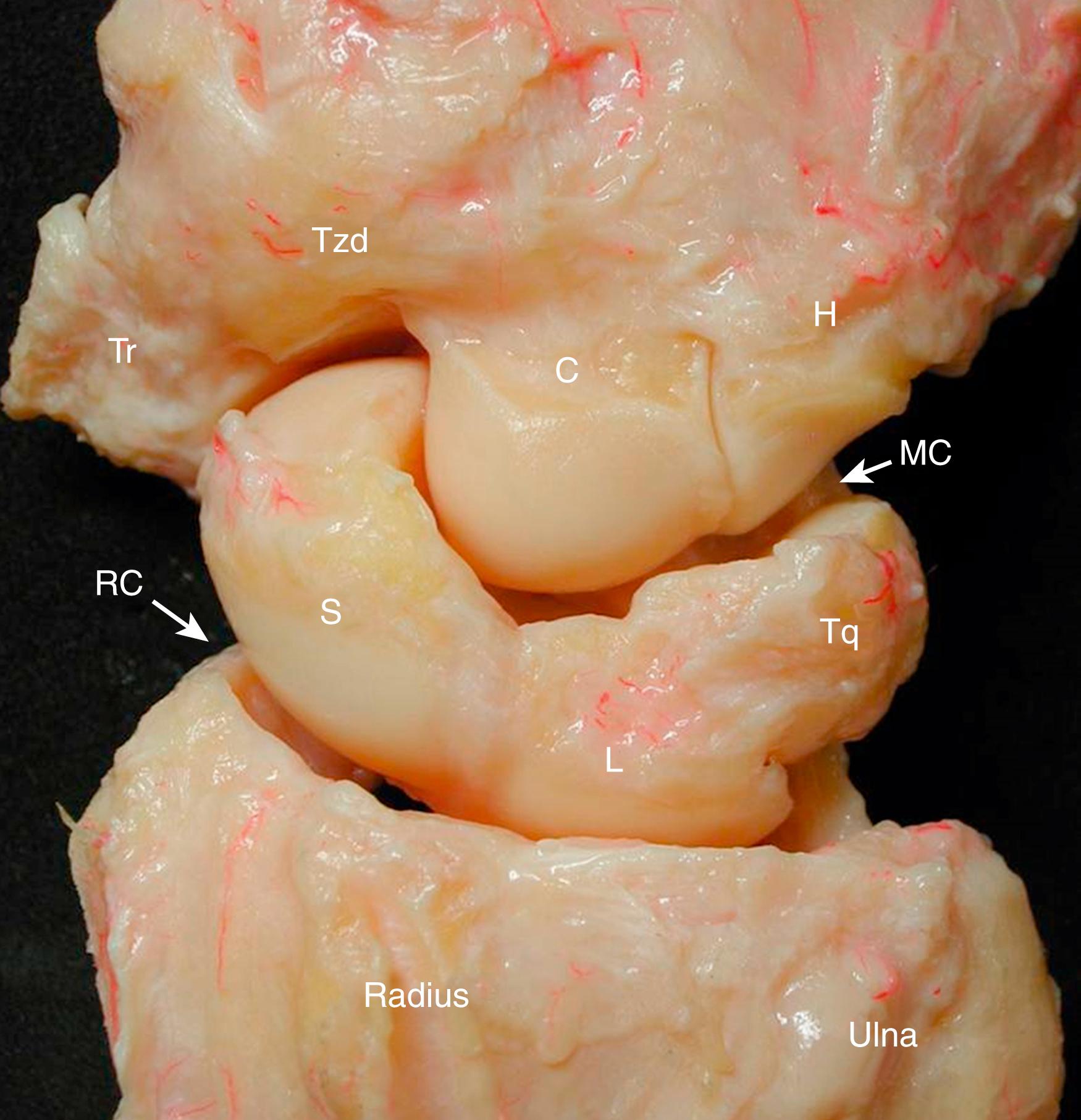
The radiocarpal joint is an oval-shaped articulation that connects the proximal convexities of the scaphoid, lunate, and triquetrum (the so-called carpal condyle) with the “antebrachial glenoid” formed by the shallow concavities of the distal radius and triangular fibrocartilage complex (TFCC). The distal radius is tilted in two planes: the sagittal plane, where there is an average 11-degree inclination toward the palm, and the frontal plane, where there is an average 23-degree inclination toward the ulna. The proximal joint surface of the scaphoid is more curved than that of the lunate. To ensure articular congruency, the radius has two articular facets (the scaphoid and lunate fossae), separated by a cartilaginous ridge of variable height.
The midcarpal joint is a combination of three types of articulations. On the radial side, the convex distal surface of the scaphoid articulates with the concavity formed by the trapezium and the trapezoid—the scaphotrapeziotrapezoid (STT) joint. This has also been referred to as the radial column. The central portion of the midcarpal joint is concave proximally and convex distally and has two bony articulations: the scaphocapitate (SC) and lunocapitate (LC) joints. The proximal row “seat” for the distal row is nearly acetabular in shape, completed by dorsal and palmar scaphotriquetral ligaments that act as labrums for the nearly spherical capitate articular surface , ( Fig. 13.2 ). The lunate may have only one distal facet articulating with the capitate (lunate type I) or have two distal facets to articulate with the capitate and proximal pole of the hamate (lunate type II). , The LC joint is the primary joint of the “central column.” On the ulnar side, the saddle-shaped distal articulating surface of the triquetrum articulates with the “helicoidal” or screw-shaped proximal surface of the hamate. This unique articulation converts compressive forces of the ulnar, or “control column” of the carpus, transmitted through the hamate, into shear forces on the triquetrum, inducing rotation and translation of the triquetrum, and rotational moments on the attached lunate through the LT ligament.
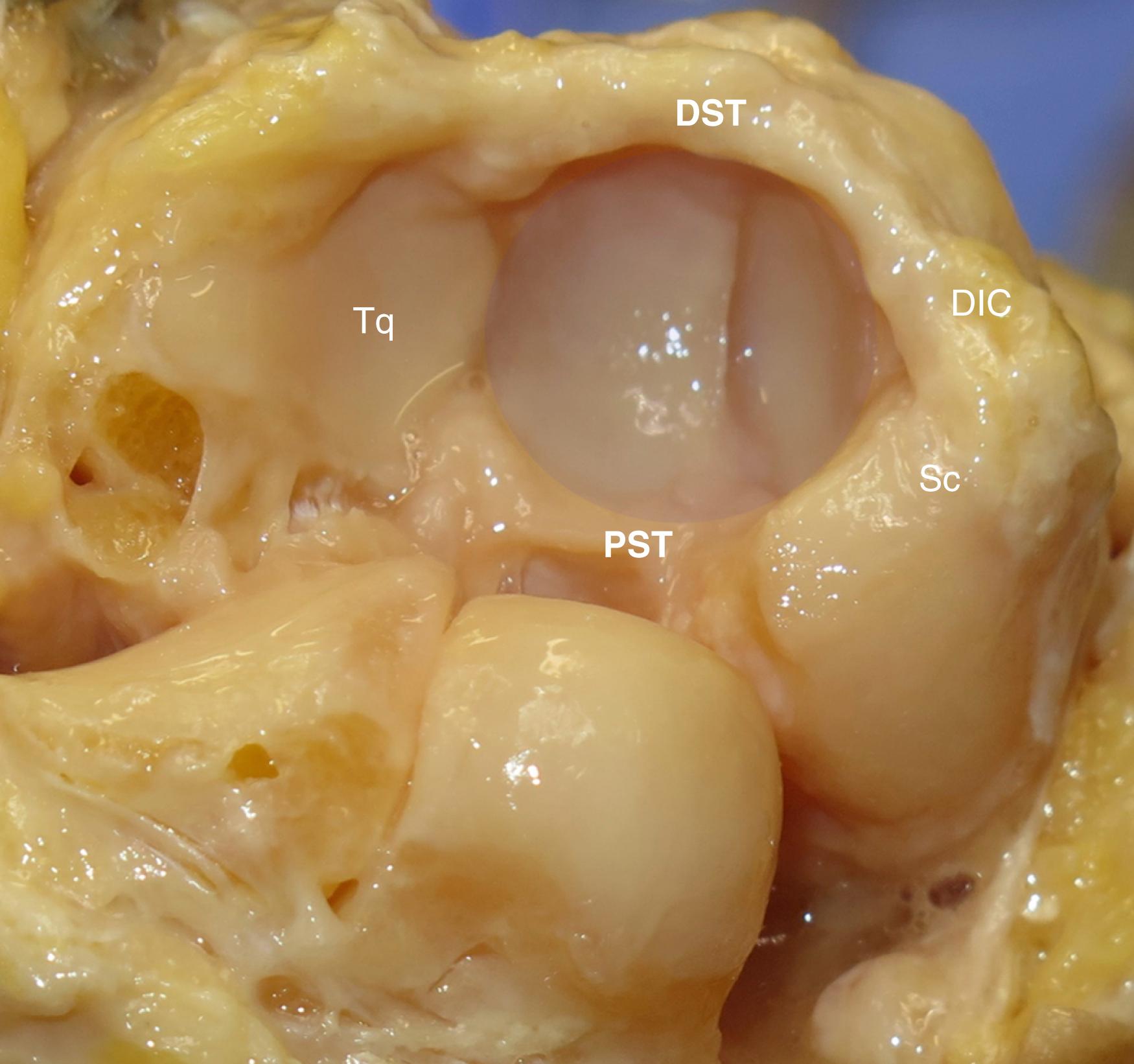
In the sagittal plane, the lunate is collinear with the capitate in only one-third of cases. In another 30%, the lunate is slightly flexed relative to the longitudinal axis of the forearm, while in the remaining 40% is slightly extended. The scaphoid is postured obliquely in approximately 45 degrees of flexion in relation to the radius (range, 30 to 60 degrees) to provide support to the thumb metacarpal, which is located anteriorly to the plane of the capitate.
In the axial (transverse) plane, the carpus forms the carpal tunnel, a palmar concavity, enclosed by the transverse carpal ligament (also known as the flexor retinaculum). The narrowest portion of the carpal tunnel is located at the level of the distal carpal row.
Multiple ligaments connect the bones of the wrist to each other. Their arrangement is complex, and their size and shape vary from one individual to another ( Fig. 13.3 ). Furthermore, as demonstrated by Hagert et al., their function may be more intricate than previously assumed. Indeed, while some ligaments are formed by tightly packed bundles of collagen fibers, and are thus important mechanically, other ligaments are less structurally packed but contain abundant mechanoreceptors and are thus important for the provision of relevant proprioception information to the central nervous system. What follows is a general description of the most common patterns of ligament arrangement. For those interested in the anatomic variations of carpal ligaments, the works by Feipel and Rooze and Viegas et al. are recommended.
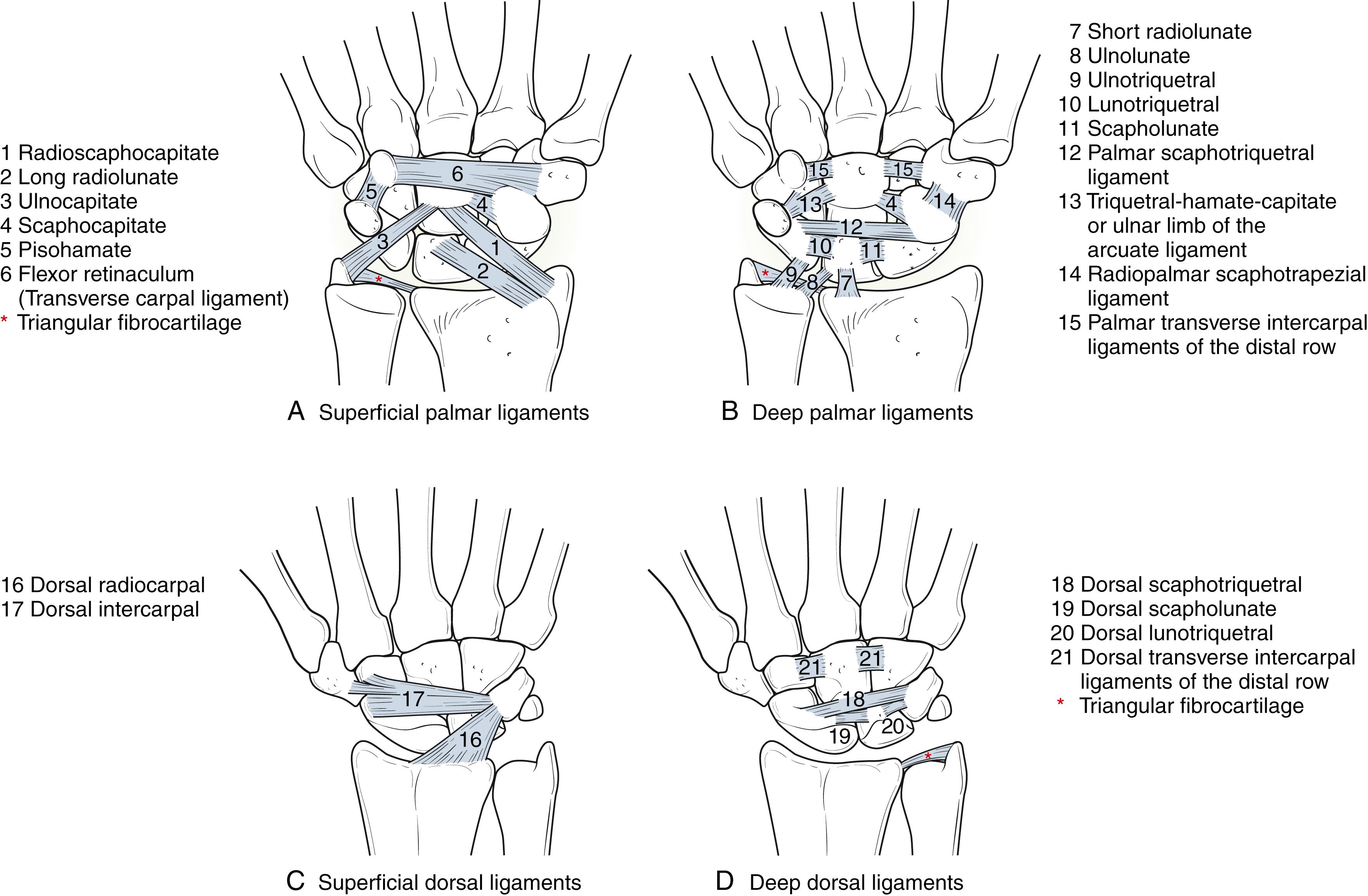
Only three carpal ligaments are extracapsular: the transverse carpal ligament and the two ligaments that connect the pisiform to the hook of the hamate and to the base of the fifth metacarpal. All other ligaments are contained within the substance of the capsule, surrounded by sheaths of loose connective tissue.
Two categories of intracapsular ligaments exist: extrinsic and intrinsic. Extrinsic ligaments are those that cross the radiocarpal and ulnocarpal joints and connect the forearm bones with the carpus. Intrinsic ligaments may be interosseous or intercarpal, may connect two or more carpal bones, and may cross the midcarpal joint. Anatomic, histologic, and biochemical differences exist between the two types. Histologically, the intrinsic SL and LT interosseous ligaments (SLIL and LTIL) are shorter and contain more type III collagen than the intercarpal and extrinsic ligaments. Both ligament types have longitudinally oriented collagen fibrils, but the collagen bundles are more densely packed in the extrinsic ligaments. There are a few elastin fibers in the extrinsic ligaments, but so sparse as to be felt to be insignificant mechanically. The interosseous ligaments contain larger amounts of fibrocartilage near their insertion sites, which likely represents their transition into both bone and articular cartilage at their insertions. As a result of the higher type III collagen and fibrocartilage composition, interosseous ligaments have the capacity to deform (stretch) more than the intercarpal and extrinsic ligaments before permanent deformation occurs, and this has been demonstrated mechanically by Nowalk and Logan. The interosseous ligaments also accept higher stress and strain levels than their intercarpal and extrinsic counterparts before ultimate failure. The LT ligament is more resilient than the SL ligament, explaining its relatively lower incidence of rupture. Both extrinsic and intrinsic ligaments exhibit differential stress-strain relationships dependent on the speed of loading. As the rate of loading increases (such as in a traumatic injury), the load supported by both extrinsic and intrinsic ligaments increases, which is an important protective property of these structures.
There are no true “collateral ligaments” that span the radial and ulnar styloid processes and the carpus in the coronal plane, as collateral ligaments would restrict radioulnar deviation. Extrinsic ligaments may be described by three major groups: palmar radiocarpal, palmar ulnocarpal, and dorsal radiocarpal ligaments ( Fig. 13.4 ). There are no true dorsal ligaments between the ulna and the carpus.
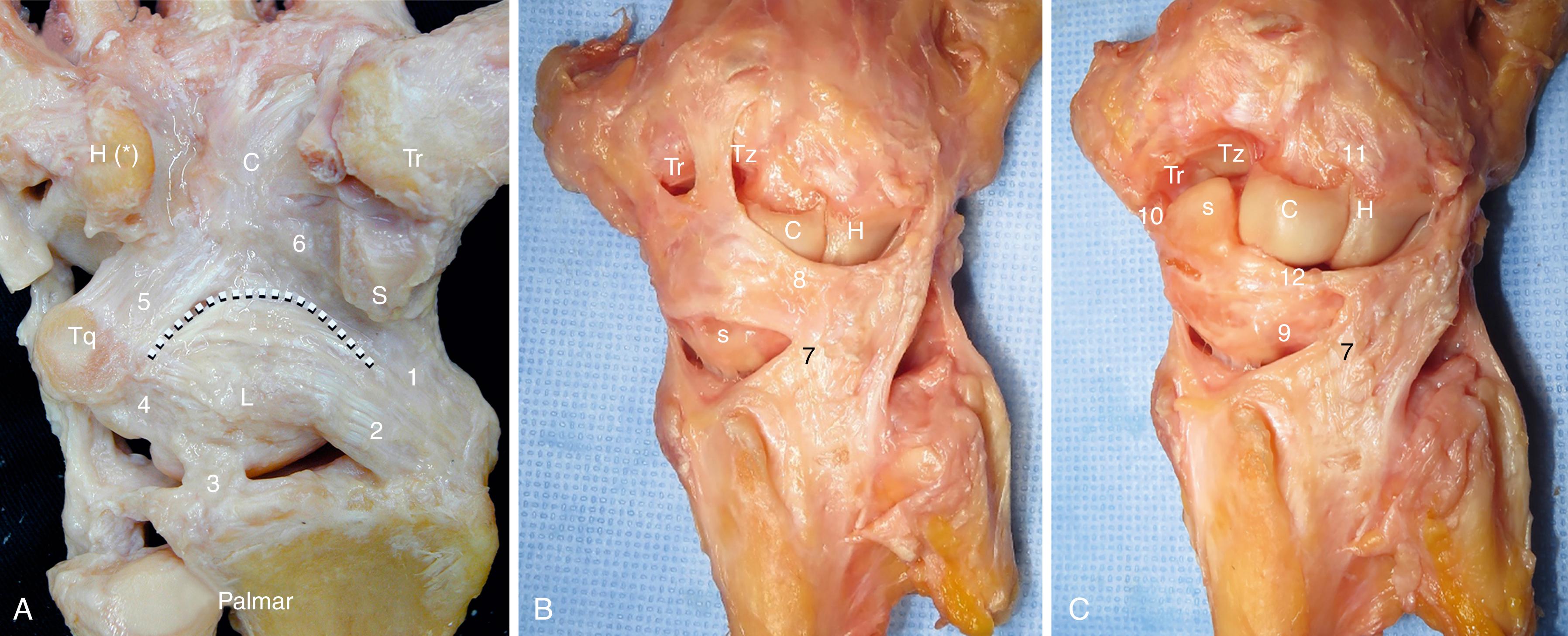
Four palmar ligaments connect the radius to the carpus: the radioscaphoid (RS), radioscaphocapitate (RSC), long radiolunate (long RL), and short radiolunate (short RL) ligaments. , The first three originate from the anterolateral margin of the distal radius and take an oblique course to insert onto the proximal edge of the scaphoid tuberosity (RS ligament), the palmar aspect of the capitate (RSC ligament), and the palmar surface of the lunate (long RL ligament). The short RL ligament originates from the anteromedial margin of the distal radius and is oriented vertically, inserting into the palmar and proximal aspect of the lunate. The RSC ligament courses around the palmar concavity of the scaphoid and inserts on the capitate, forming a sling over which the scaphoid rotates. The “ligament of Testut” or radioscapholunate (RSL) ligament was long considered an important deep intracapsular ligament. The RSL is no longer considered a true ligament but a bundle of loose connective tissue containing vessels supplying the SL interosseous membrane and adjacent osseous structures.
There are three palmar ulnocarpal ligaments: one superficial (ulnocapitate) and two deep (ulnotriquetral and ulnolunate). , , The ulnocapitate ligament arises from a rough surface at the base of the ulnar styloid (i.e., the basi-styloid fovea) and courses distally to attach onto the neck of the capitate. The distal insertions of the ulnocapitate ligament blend with those of the intrinsic triquetrocapitate ligament before inserting onto the capitate. The combined ligaments form the ulnar bundle of the arcuate ligament, while the RSC and SC ligaments form the radial bundle. Deep to the UC ligament, arising from the triangular fibrocartilage, are the ulnotriquetral (UT) and ulnolunate (UL) extrinsic ligaments that run distally and radially toward their insertions into the anterior aspect of the triquetrum and lunate, respectively. These and the superficial UC ligament form the so-called ulnocarpal ligamentous complex. The ulnocarpal and radiolunate ligaments form the inverted “proximal V” of the palmar ligamentous complex. Between the distal and proximal V’s of the palmar ligamentous complex is a relatively weak capsular zone (the space of Poirier) (see Fig. 13.4A ) through which perilunate dislocations frequently occur.
The only dorsal extrinsic ligament is a critical stabilizing structure of the proximal carpal row—the dorsal radiocarpal (DRC) ligament. The DRC is a wide, fan-shaped ligament that connects the dorsal middle third of the distal articular surface of the radius to the dorsal lunate , , and to the tubercle of the triquetrum (see Figs. 13.3C and 13.4B ). As it crosses the LT joint, it inserts onto the dorsal distal aspect of the LT interosseous ligament and also receives a strong reinforcement from the retinacular septum dividing the fourth and fifth dorsal extensor compartments. Similarly, the retinacular septum between the third and fourth dorsal compartments fuses with the DRC on its radial margin near the Lister tubercle. The DRC has four variations of its origin, including an accessory origin from the radial dorsal margin of the radius deep to the second dorsal compartment and one from the far dorsoulnar radius. There are no dorsal ligaments between the ulna and the carpus.
Intrinsic carpal ligaments include collections of relatively short fibers that connect neighboring bones of the same carpal row (interosseous ligaments), longer dorsal or palmar ligaments that span bones of the same row, or ligaments that span the midcarpal joint and link the two rows together (intercarpal ligaments).
The SL linkage consists of three distinct but continuous portions of a complex C-shaped structure: the two SL ligaments (palmar and dorsal) and the proximal fibrocartilaginous membrane ( Fig. 13.5 ). The dorsal SL ligament (dSLIL) connects the dorsal and distal margins of the scaphoid and lunate. It is formed by a thick collection of fibers, slightly obliquely oriented, and plays a primary role in scaphoid stability. The dSLIL interdigitates dorsally with fibers of the dorsal scaphotriquetral ligament and the dorsal intercarpal ligament (DIC), which continues radially to insert along the dorsal ridge of the scaphoid waist. , The anterior counterpart of the dSLIL is the palmar SL ligament, which has longer, more obliquely oriented fibers, and allows substantial flexion and extension of the scaphoid relative to the lunate. The dSLIL has the greatest yield strength, 270 newtons (N) on average, followed by the palmar SL ligament (118 N) and the proximal membrane (63 N). The ligament has considerable torsional flexibility, with a neutral zone (physiologic laxity) of 30 degrees and a 47-degree range of rotation. The proximal membrane is formed by fibrocartilaginous tissue that separates the radiocarpal and midcarpal joints and is often perforated in older or active individuals. Perforation of the proximal SLIL may be recognized by arthrographic leakage of dye between the radiocarpal and midcarpal joints, and does not necessarily indicate instability.
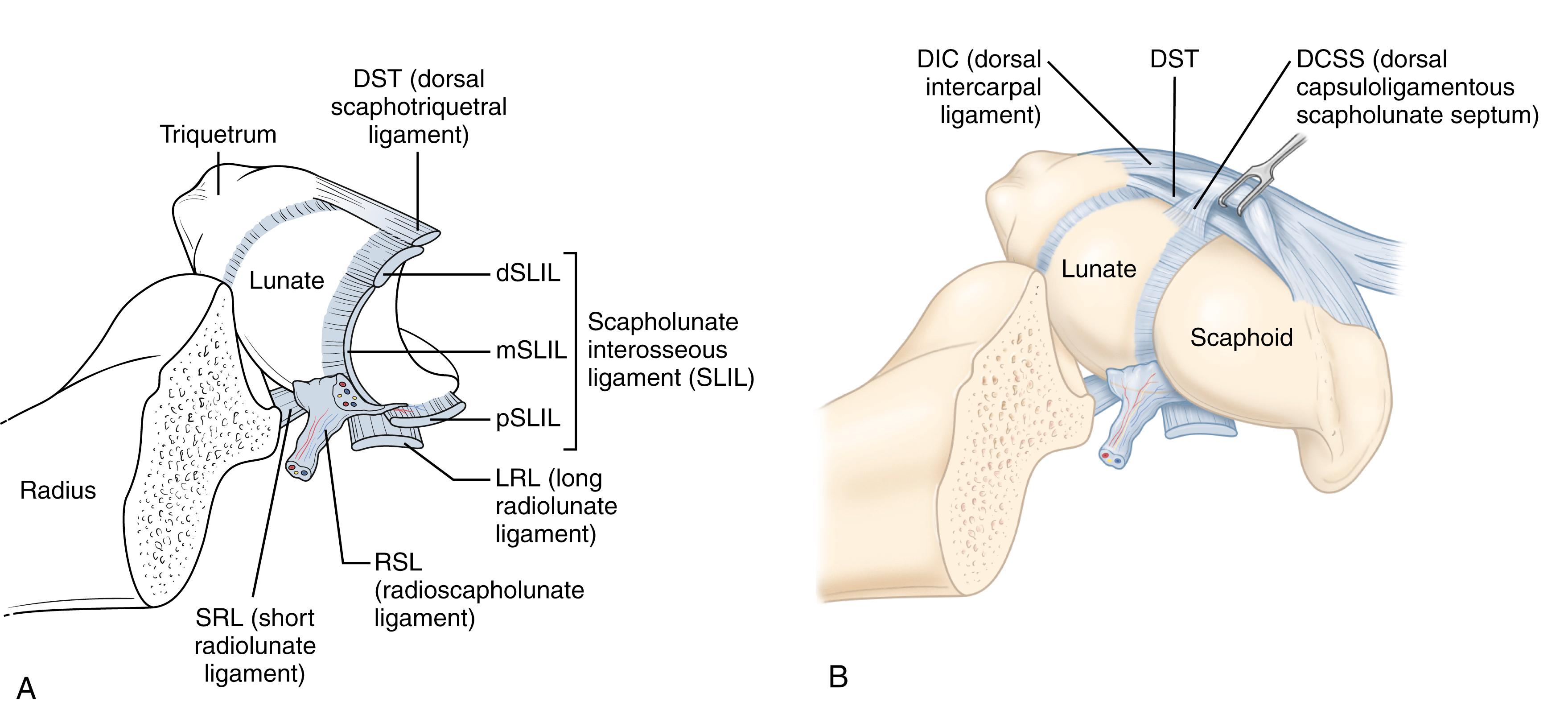
The LT joint similarly has two interosseous ligaments (palmar and dorsal) connecting the palmar and dorsal aspects of the two bones and a continuous fibrocartilaginous membrane closing the joint proximally and separating the midcarpal and radiocarpal joints. In contrast to the SL ligaments, the palmar LT ligament is thicker and stronger than its dorsal counterpart (average yield strengths: 301 N and 121 N) with the proximal portion being the weakest (64 N). , The fibers of the two interosseous LT ligaments are more taut through all ranges of motion than those of the SL ligaments, making for a closer kinematic relationship. ,
Three intrinsic ligaments span bones of the proximal carpal row: the dorsal and palmar scaphotriquetral ligaments and the dorsal intercarpal ligament. The dorsal scaphotriquetral (DST) ligament spans the dorsal-distal rims of the scaphoid, lunate, and triquetrum; is of variable width; and is in a plane just superficial to the dorsal SL interosseous and the dorsal LT interosseous ligaments. The DST lies deep and attached to the DIC proper. , Controversy surrounds the DST ligament, as to whether it represents a separate ligament or whether it represents the deep fibers of the dorsal intercarpal ligament. New histologic and magnetic resonance imaging data demonstrate that the DST ligament represents both a robust attachment of the transverse fibers of the DIC to each bone of the proximal carpal row and a labral extension of the interosseous SL and LT ligaments across the dorsal base of the capitate. The analogous structure on the palmar side of the carpus, the palmar scaphotriquetral ligament, spans transversely from the waist of the scaphoid to insert just palmar and distal to the LT ligament on the triquetrum. The ligament is 2 mm wide and passes dorsal to the RSC, separated from the capitate by a synovial fold. The dorsal and palmar scaphotriquetral ligaments complete a near-acetabular shaped articulation for the capitate (see Fig. 13.2 ). The recently described dorsal capsuloligamentous scapholunate septum (DCSS) is a fibrous capsular structure that originates from the deep surface of the intracapsular DIC and inserts on the dSLIL and which has been described as an additional stabilizer of the SL joint , (see Fig. 13.5B ).
The third and most important intrinsic ligament spanning the bones of the proximal carpal row is the DIC. Through the DST’s robust connections to the dorsal SL and LT interosseous ligaments, and its insertions on the dorsal lunate and the dorsal ridge of the scaphoid, , the DIC is a critical stabilizer of the proximal carpal row. The DIC has a distal component that inserts on the trapezoid and trapezium, crossing the capitate neck and thus adding stability to the midcarpal joint (see Fig. 13.4B ). There are no ligaments, palmar or dorsal, between the lunate and capitate.
The midcarpal joint is crossed by four additional palmar intercarpal ligaments: palmar triquetrohamate (TH), triquetrocapitate (TC), SC, and the radiopalmar STT ligament. , The TH and TC ligaments (also called the ulnar arm of the arcuate ligament) are thick structures, variable in size and shape, that play an important role in the stabilization of the midcarpal joint. , Their anatomy varies according to the type of lunate (I or II). , , The scaphoid tuberosity is linked to the distal row by the anteromedial SC ligament and the stout radiopalmar STT ligament. The strong ligamentous attachments of the scaphoid to the distal carpal row are considered to be important stabilizers of the proximal carpal row, and disruption of these ligaments has been associated with both dissociative and nondissociative instability patterns of the proximal carpal row. , , ,
The distal carpal row bones are strongly bound to each other by stout transverse intercarpal ligaments (i.e., dorsal and palmar intrinsics). They are essential to ensure the rigidity of the transverse carpal arch and to protect the carpal tunnel contents. The capitate and hamate have only 2 degrees of intercarpal rotation and less than 2 mm of proximal-distal translation.
The wrist is a highly mobile composite articulation that links the two forearm bones to the hand, characterized by its ability to sustain substantial load without yielding. This can only be achieved through a perfect interaction between wrist tendons, joint surfaces, and soft tissue constraints and is coordinated by a complex neuromuscular control system. Over the past 125 years, different theories have been proposed to explain the intricate mechanisms of the wrist, yet no consensus has been achieved regarding a “universal” theory of wrist kinematics ( Box 13.1 ). What follows is a brief description of how the wrist moves (wrist kinematics) and how it sustains physiologic loads without yielding (carpal kinetics).
Bryce (1896) The carpal bones are arranged into two carpal rows (proximal and distal) each moving as a rigid functional unit about two transverse joints (radiocarpal and midcarpal).
Navarro (1935) The carpal bones are arranged into three vertical, interdependent columns: (1) the central column (lunate, capitate, and hamate) controls flexion-extension of the wrist; (2) the lateral column (scaphoid, trapezium, and trapezoid) controls load transfer across the wrist; and (3) the medial or rotational column (triquetrum and pisiform) controls pronosupination.
Gilford et al. (1943) The central column of the wrist (radius-lunate-capitate) is mechanically arranged as a “link joint,” which “crumples” when the scaphoid is either fractured or dissociated from the lunate by scapholunate ligament injury.
Landsmeer (1961) Described the “intercalated bone” as a single segment of a linear articulated skeleton, which, like the middle phalanx of a digit, responds to mechanical signals from the neighboring phalanges and from the musculotendinous units spanning the phalanx.
Linscheid et al. (1972) Defined the “intercalated segment” as the lunate and triquetrum, which the authors claimed moved synchronously throughout wrist motion. They further defined the two predominant postures of dissociative carpal instability, namely dorsal intercalated segment instability (DISI) and volar intercalated segment instability (VISI), which occur following ligament disruption of the proximal carpal row.
Taleisnik (1978) Modification of the columnar theory. The entire distal row is included with the lunate as the force-bearing central column. The scaphoid represents the lateral column and the triquetrum the medial column. The pisiform is excluded from the model.
Weber (1980) Three columns: the load-bearing column (base of second and third metacarpals, trapezoid, capitate, proximal two-thirds scaphoid, and lunate), the control column (triquetrum and hamate), and the thumb column (thumb metacarpal, trapeziotrapezoid joint, and distal one-third scaphoid). Of key importance is the helicoidal joint between the triquetrum and hamate, which drives lunotriquetral alignment in the sagittal plane during wrist radioulnar deviation.
Lichtman et al. (1981) The carpus functions as an oval ring formed by four interdependent elements (distal row, scaphoid, lunate, and triquetrum) connected to the adjacent segments by ligamentous links (see Fig. 13.6 ).
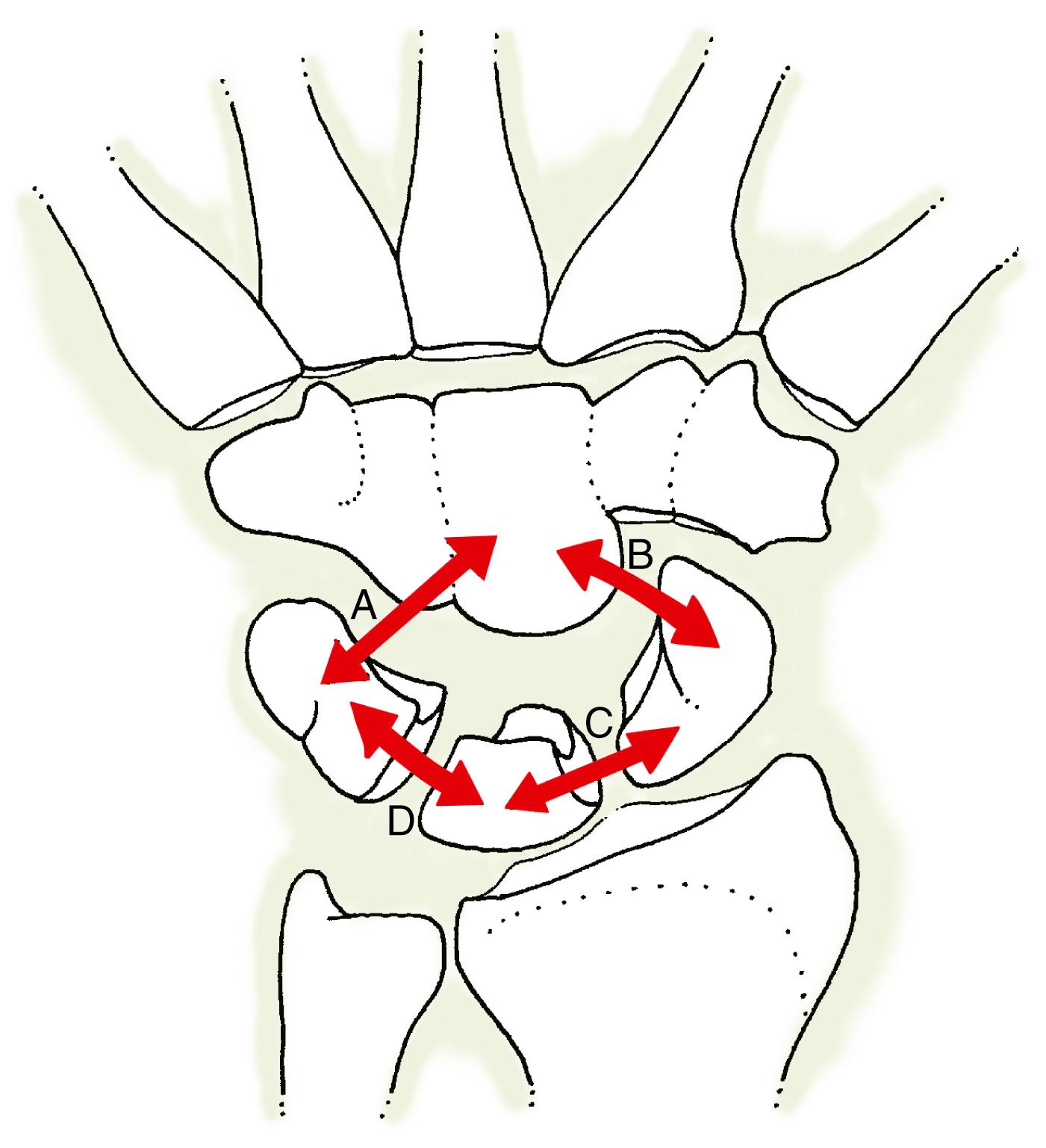
Craigen and Stanley (1995) Two predominant patterns of motion exist during radioulnar deviation and are predicated on the degree of ligament laxity: The proximal row rotates mostly along the frontal plane (row pattern) or mostly along the sagittal plane (column pattern).
Crisco et al. (2005, 2011) , The dart-thrower’s path of radial extension to ulnar flexion defines the transition between flexion and extension of the scaphoid and lunate, and a path of motion during which the proximal row motion approaches zero. The dart-thrower’s motion (DTM) occurs almost exclusively through the midcarpal joint, and DTM rotation occurs along the mechanical axis of the wrist.
Sandow et al. (2014) The lunate, capitate, hamate, trapezium, and trapezoid function collectively as the “stable central column,” controlled by the scaphoid in a two-gear, four-bar linkage system and stabilized by the triquetrum, which buffers lunate rotation and prevents ulnar translation.
The wrist can essentially be considered to be a two-joint system linking the hand (described as the distal carpal row and the metacarpals) to the forearm (radius and ulna) around the highly mobile bones of the proximal carpal row. The two principle articulations are the radiocarpal and midcarpal joints, situated proximal and distal to the mobile proximal carpal row. Motion of the wrist can occur passively when an external force is applied to the hand, or actively, when the forearm muscles contract. “Global” motions of the hand in relation to the fixed forearm include the anatomically defined planar motions of flexion/extension and radioulnar deviation, the “coupled” oblique planar motions such as radial-extension to ulnar-flexion (e.g., dart-thrower’s motion), and a series of coupled motions that constitute circumduction.
In kinematic terms, the bones of the distal carpal row and the index-middle metacarpals can be thought of as a single rigid functional unit, whose motion is initiated by the forearm tendons inserting at the metacarpal bases. The three mobile bones of the proximal carpal row have no direct tendon attachments, hence they respond passively to mechanical signals from the distal row when tension within the intercapsular ligaments reaches a certain level.
The three bones of the proximal carpal row are less tightly bound to one another than the bones of the distal carpal row due to the increased elasticity of the interosseous ligaments. With respect to the fixed radius, the proximal row bones move in the same primary direction of flexion-extension, albeit to different amounts, regardless of the direction of wrist motion. When the wrist is constrained to a fixed flexion-extension plane of motion, the proximal and distal rows move in relative synchrony. The scaphoid has a larger amount of rotation in this plane (average 86% of the total arc of motion) than the lunate (57%) and the triquetrum (65%). It is not surprising then to find that the average SL angle in full wrist flexion is 35 to 47 degrees greater than in full extension , ( Fig. 13.7 ). While one might surmise that the scaphoid’s rotation on the lunate would be along a single axis that pierces their adjoining articular surfaces, a recent kinematic study demonstrates the flexion-extension and radioulnar axes of the SL joint to be located at least 5 mm away from the lunate’s centroid. The offset location of this axis makes reconstruction of normal kinematics following SL dissociation impossible by using a single screw or graft in a fixed “axis” located within the bones.
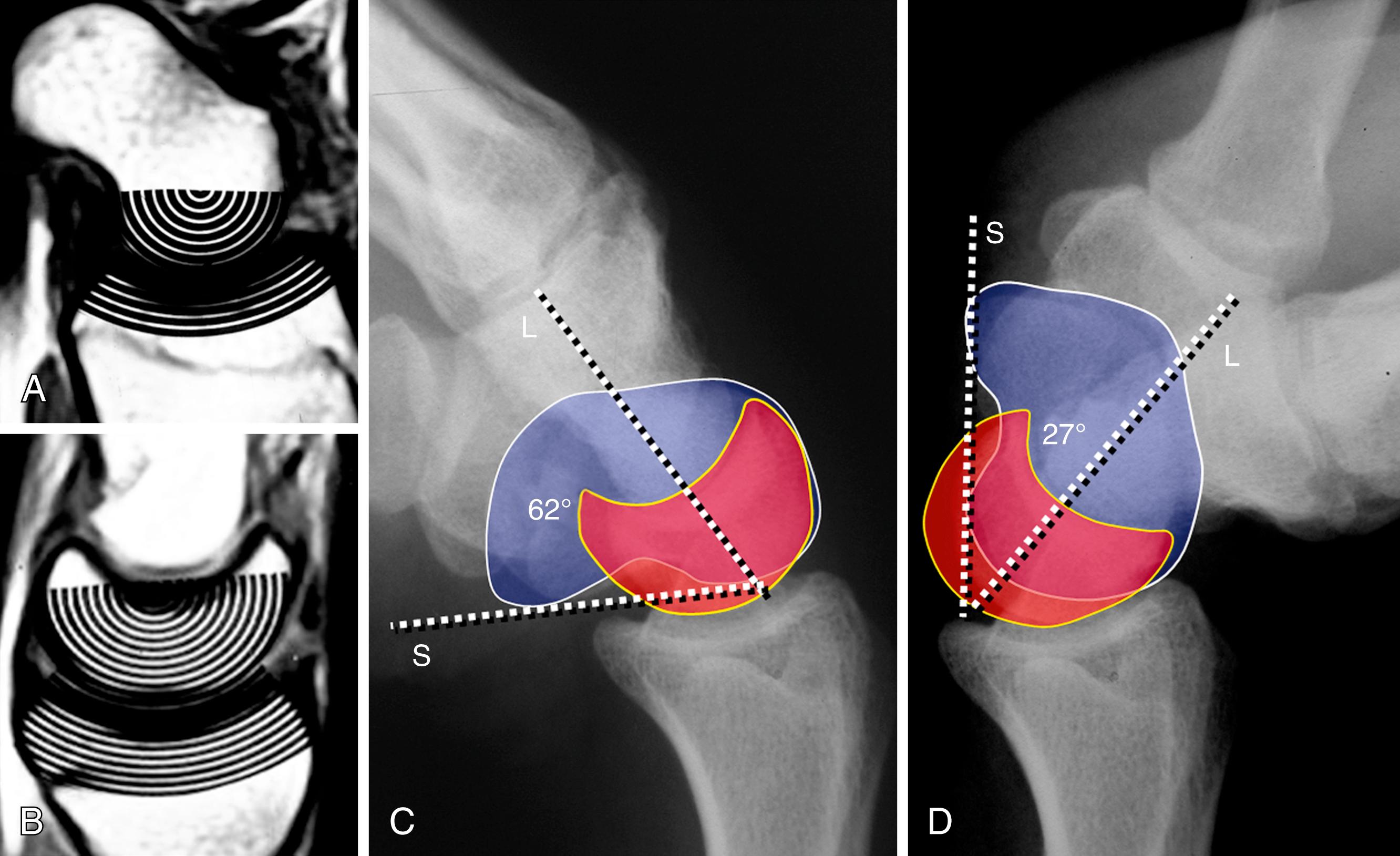
During radial to ulnar rotation of the wrist, however, the proximal and distal carpal rows move in different planes. The distal carpal row translates dorsally as it rotates in the frontal plane. The three proximal carpal bones move together but rotate in the sagittal plane, from a flexed position in radial deviation to an extended position in ulnar deviation ( Fig. 13.8 ). Craigen and Stanley determined that the magnitude of this out-of-plane motion varies substantially from one individual to another. In most individuals, the proximal carpal row rotates predominantly around the flexion-extension axis during radioulnar deviation, whereas in a few there is more radioulnar translation than flexion-extension during this motion. In between the two extremes, there is a spectrum of combined behavior depending on a number of individual variables, including wrist laxity, shape of the capitate-hamate proximal surface, carpal bone position, or type of lunate. ,
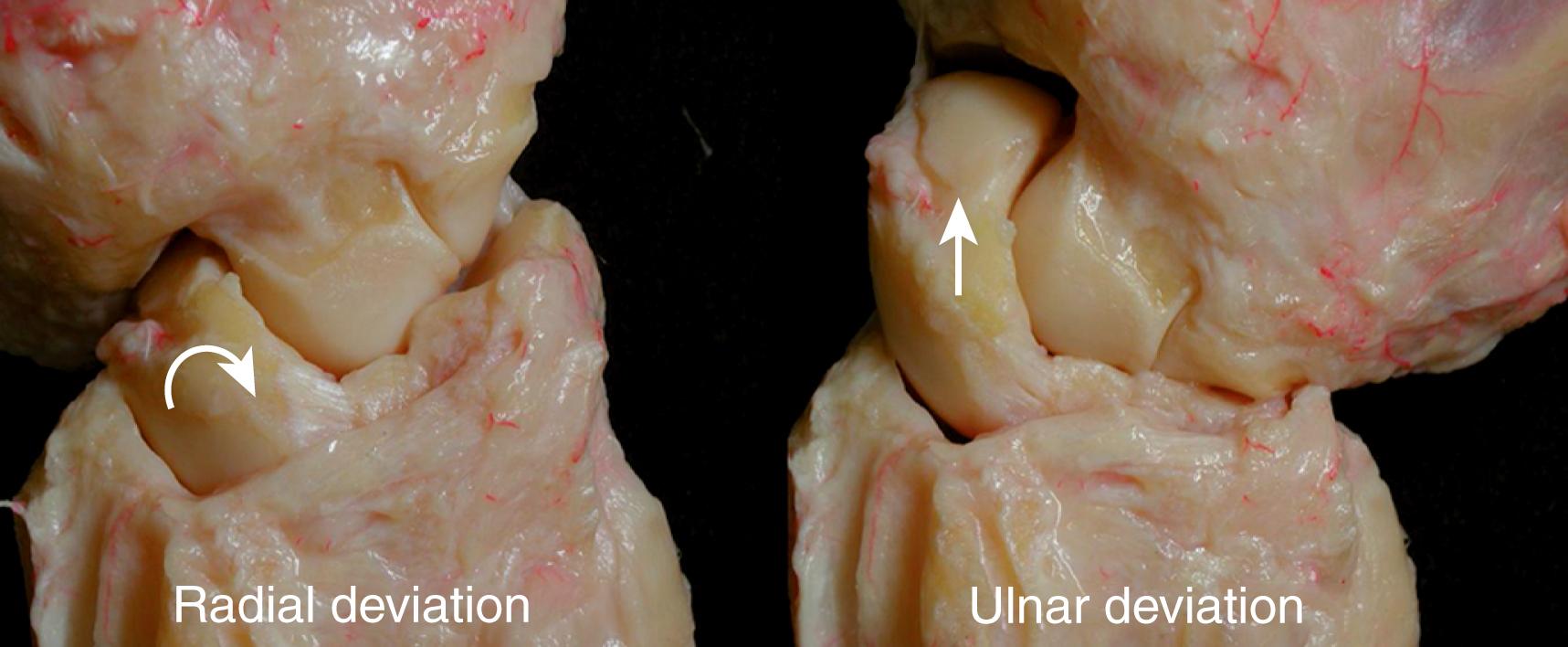
These observations, and the high degree of individual variability, argue against a strict adherence to a particular theory of carpal kinematics. From the authors’ perspective, several important concepts underscore the importance of the “row” theory to normal carpal kinematics: (1) All bones of each row rotate in the same primary plane during any direction of global wrist motion ; (2) in all but pure flexion/extension of the uninjured wrist, the proximal and distal rows move in divergent directions; (3) division of either of the proximal row’s interosseous ligaments in isolation does not result in a postural deformity of the lunate , , , , ; and (4) similar “collapse” deformities of proximal row alignment (VISI or DISI) can occur with or without disruption of an interosseous ligament (“dissociative” or “nondissociative”). The last observation implies that the proximal row has its own critical intrinsic and extrinsic ligament stabilizers.
Disparities between different theories of carpal kinematics may also derive from the somewhat arbitrary orthogonal planes of motion represented by standard radiographs and utilized in laboratory cadaveric studies and computational models (posteroanterior [PA] or frontal) and lateral (sagittal). These planes of motion are seldom utilized in occupational activities, activities of daily living, or sporting activities. The most commonly used “functional” plane of motion begins in extension and radial deviation and ends in flexion and ulnar deviation. Fisk described this plane as “when someone is casting a fly or throwing a dart”; thus it is commonly referred to as the “dart-thrower’s” motion (DTM). The obliquity of the optimal functional DT plane of motion is unique to each individual (and perhaps each activity), ranging from 37 to 59 degrees from the sagittal plane, according to various authors. , , , This oblique plane of wrist motion, generated by the two powerful radial wrist extensors—extensor carpi radialis longus (ECRL) and extensor carpi radialis brevis (ECRB)—and the muscle with the greatest cross-sectional area in the forearm, the FCU, is the dominant plane of motion in activities of daily living, as well as recreational and occupational activities.
The study of three-dimensional (3D) carpal kinematics using markerless bone registration (MBR) is ideally suited for studying individual carpal bone kinematics in live subjects during wrist motion, especially in combined or “coupled” motion planes. , A series of studies of DTM from radial extension to ulnar flexion independently confirmed that proximal row flexion during wrist flexion is balanced by extension forces during ulnar deviation, such that the proximal row remains nearly stationary during this motion path. , , The stability of the proximal row in this motion plane underscores the critical importance of the midcarpal joint to functional activities such as hammering or throwing, and has been proposed to have had implications in homo sapien evolution. Further cadaveric research identified that the mechanical axis of the wrist is collinear with the dart-throwing axis and lies oblique to the anatomic axes of the wrist ( Fig. 13.9 ). The unusual behavior of the proximal row during DTM cannot be adequately explained by any of the prevailing theories of carpal kinematics and ushered in an era of “functional kinematic” analysis. This line of research measures the kinematics of normal, injured, and postreconstructive patients in real time during activities, using gait lab technology, biplanar video fluoroscopy (BVR), or electrogoniometry.
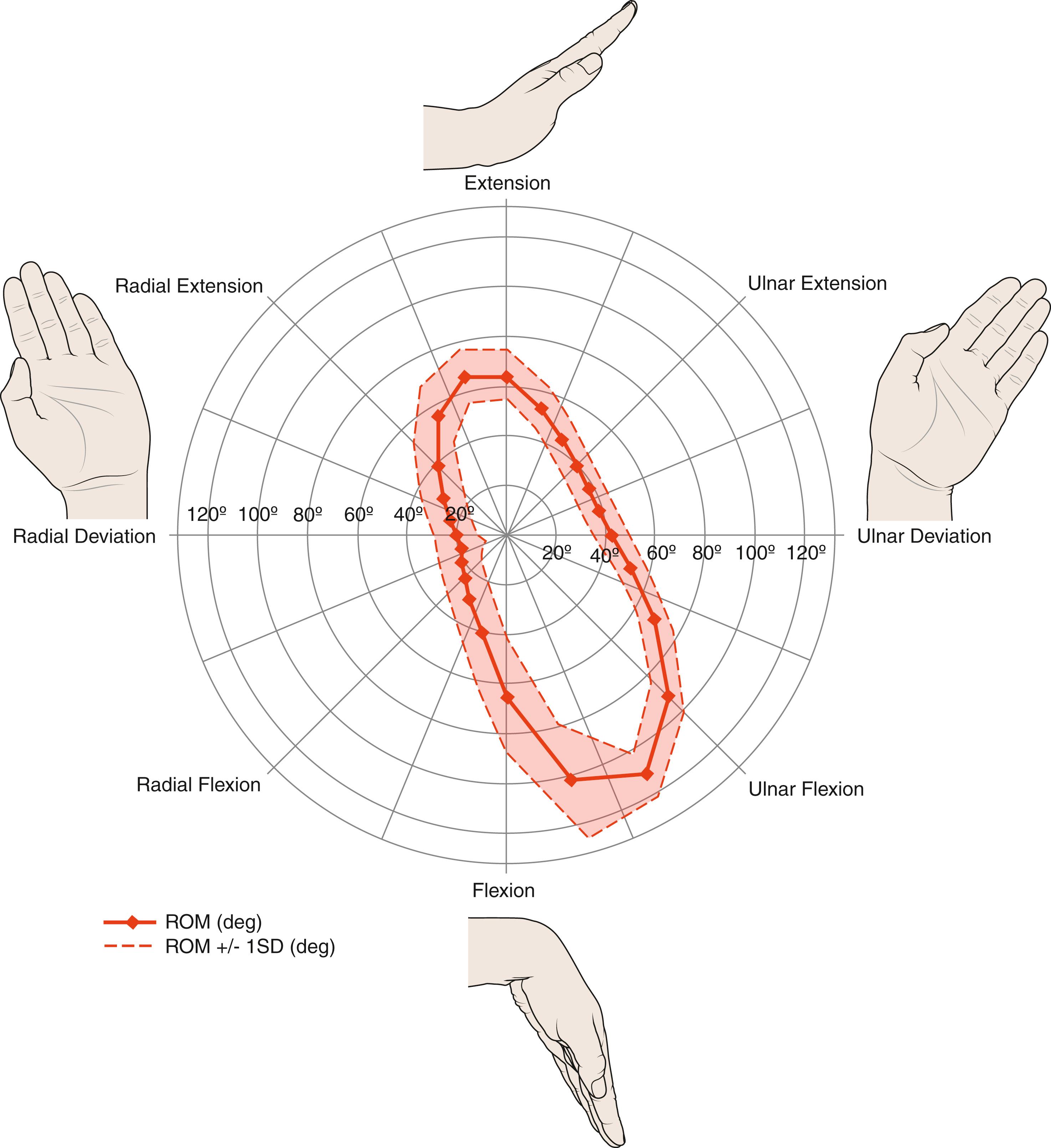
The opposite rotation, from extension–ulnar inclination to flexion–radial inclination, has been referred to as the reversed dart-thrower’s motion. It is a rotation mediated by the FCR on the volar side and the extensor carpi ulnaris (ECU) on the dorsal side of the wrist. As opposed to what happens during DT rotation, the contribution of the midcarpal joint to the reversed dart-thrower’s type of rotation is minimal: this motion occurs predominantly through the radiocarpal joint. The very limited range of motion (ROM) attainable in this plane exemplifies the importance of a two-row, two-joint system of normal wrist function that utilizes joint axes situated in two planes angled at 45 degrees to each other. This concept was first advanced by Henle in 1871 as a “universal” or cardan joint, wherein two joint axes are aligned in different planes to transmit torques in multiple directions and permit complex motions , ( Fig. 13.10 ).
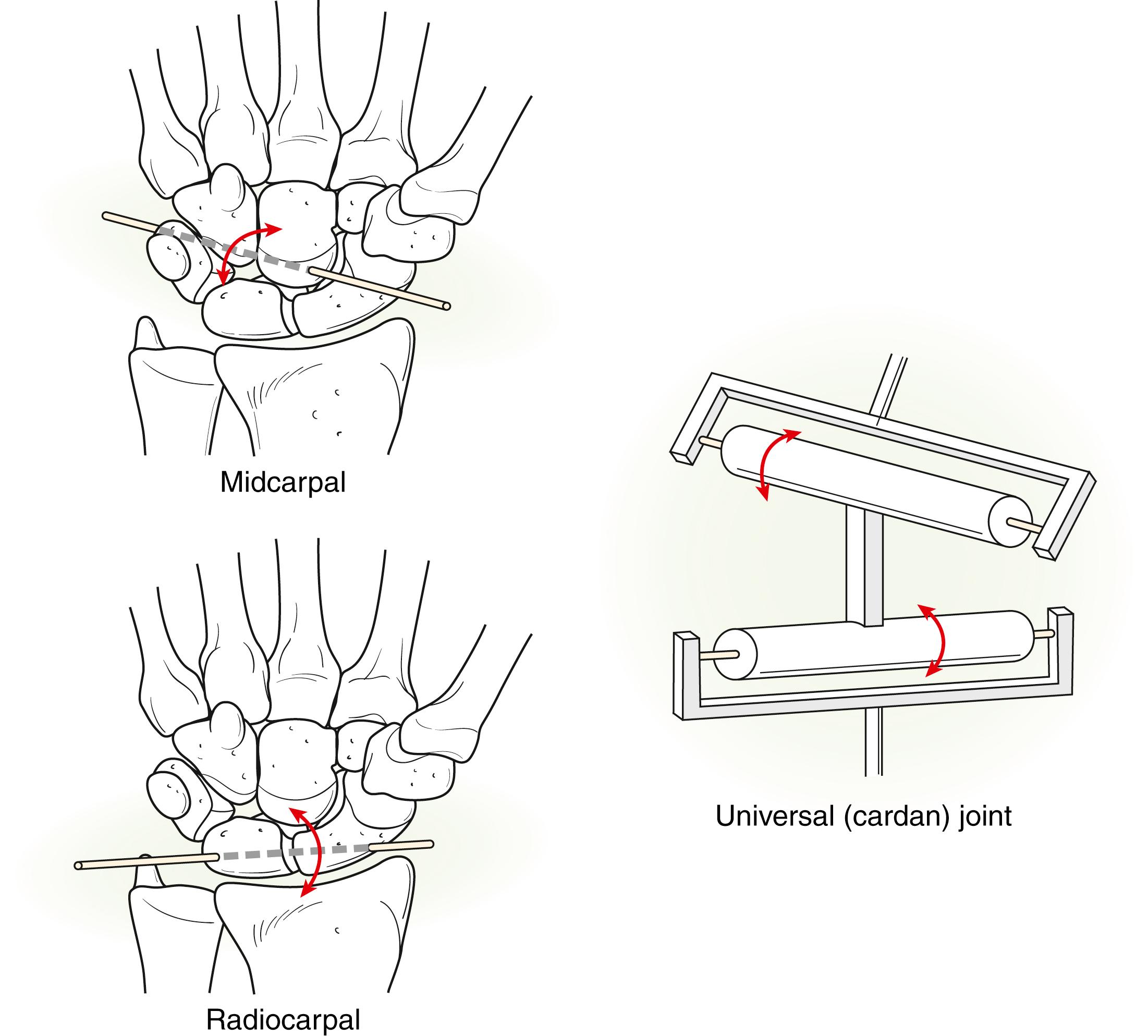
Sandow utilized a “rules-based” computational model of five human wrists in several different positions of flexion/extension and radioulnar deviation to propose and test a “two-gear, four bar” linkage of the proximal and distal rows. The computational model predicts carpal kinematics based on the isometry of the major capsular stabilizing ligaments. Building on the cardan concept above, the proximal row and distal row axes are oriented approximately 45 degrees to each other in the axial plane, but in this model the relationship varies as the proximal row moves. As this technique involves 3D-computed models of an individual patient’s carpus, a patient-specific kinematic model can be built and utilized for surgical planning and virtual surgery, simultaneously obviating the difficulties encountered with individual anatomic differences and ligament laxity.
The mechanism of active intracarpal pronosupination of the carpus has recently been elucidated , and can be explained as follows. Distal to the extensor retinaculum, the wrist tendons change direction, taking an oblique path to their distal insertion. The ECU tendon, for instance, from a dorsal position at the level of the ulnar head, courses obliquely toward its distal insertion onto the dorsoulnar corner of the fifth metacarpal. The ECRL and the abductor pollicis longus (APL) also have an oblique course but in the opposite direction, toward the lateral border of the wrist.
Each of these tendons is collinear with the forearm at the radiocarpal level but diverges distally toward their ulnar or radial insertions. If the wrist is in a neutral position, isolated isometric contraction of any of these muscles will generate a pronation or supination moment to the distal row: ECU and FCR muscle contraction will cause distal row pronation, whereas the ECRL, FCU, and APL muscles will induce a supination moment to the distal row. These intracarpal motions have important implications to rehabilitation of the ligament-injured wrist. ,
Hand function generates a considerable amount of force that is transmitted across the carpometacarpal (CMC) joints into the carpus. , , Kinetics can be conceptualized as occurring along the carpal columns, while kinematics occurs predominantly within and about the proximal carpal row. Loads from the hand are transmitted along the metacarpals and distributed among the three columns. The lateral column (STT joint) transmits approximately 30%, the central column (SC and LC joints) transmits approximately 50%, and medial column (TH joint) transmits approximately 20%. As is the case with carpal kinematics, there is considerable variability of load distribution based on anatomic variation, ligament laxity, and individual factors. The fact that most ganglion cysts emerge from the SL interval suggests that the interval between the central and lateral columns is a particularly stressed area; indeed, ganglions tend to develop within chronically strained ligaments.
At the radial articular surface, approximately 50% of the total load is transmitted across the RS joint (scaphoid fossa), 35% across the RL joint (lunate fossa), and 15% across the TFCC into the ulna. , The average pressure values within the radiocarpal joint may be as high as 5.6 MPa, which is approximately 0.5 N/mm 2 or 810 lb/in 2 . These figures vary substantially with wrist position. The lunate fossa is increasingly loaded with ulnar inclination, and the scaphoid fossa with radial inclination. When the wrist is in the “position of function” (i.e., slightly extended and radially inclined), the lunate tends to carry more load than the scaphoid.
When axially loaded, the carpal bones accommodate with slight changes in their resting posture. The magnitude and direction of these postural changes depend on the orientation and point of application of the incoming loads, and the status of the various soft tissue constraints (i.e., capsule, ligaments, muscles). A wrist is considered “stable” when it is able to sustain physiologic loads in all positions without experiencing abnormal carpal displacement. For this to happen, the articular surfaces must be normally oriented and congruous, the ligaments must all be present and active, and the musculotendinous forces acting on the carpal bones must be unaffected by disease or injury. Knowledge of the different stabilizing mechanisms is crucial to fully understand and successfully treat carpal pathology.
The proximal carpal row, suspended between the radius and the distal carpal row with no tendon insertions, is inherently unstable. If not for the capsule, ligaments, and muscles, the three bones would “crumple” as Gilford et al. observed, when compressed by the distal carpal row against the radius. Instead, because of its oblique orientation relative to the long axis of the forearm and to the neighboring trapezium, the loaded scaphoid tends to rotate into flexion and pronation, and the distal carpal row pronates around the nearly spherical scapholunocapitate articulation. Distal row pronation translates the hamate dorsally, creating a counterbalancing extension moment to the triquetrum through its ligament constraints. If both palmar and dorsal SL and LT ligaments are intact, such differences in angular rotation generate increasing torque and intercarpal coaptation of the SL and LT joints, further contributing to the proximal row’s stability. Further, the proximal row is reinforced by an array of radiocarpal and midcarpal-crossing ligaments. Critical proximal row stabilizers are the STT and SC ligaments laterally, the Triquetrohamatecapitate (THC) ligament medially (the so-called ulnar bundle of the arcuate ligament), the long RL ligament palmarly, the DRC (through its insertion on the lunate and triquetrum), and the dorsal intercarpal ligament (through its DST attachments to the dorsum of each proximal row bone and the dSLIL). , , , Based on this complex interrelationship, if the SL or LT ligaments are ruptured in isolation, the proximal carpal row will not collapse ( Fig. 13.11 ). This may help explain how so many SLIL injuries are missed in the acute stage.
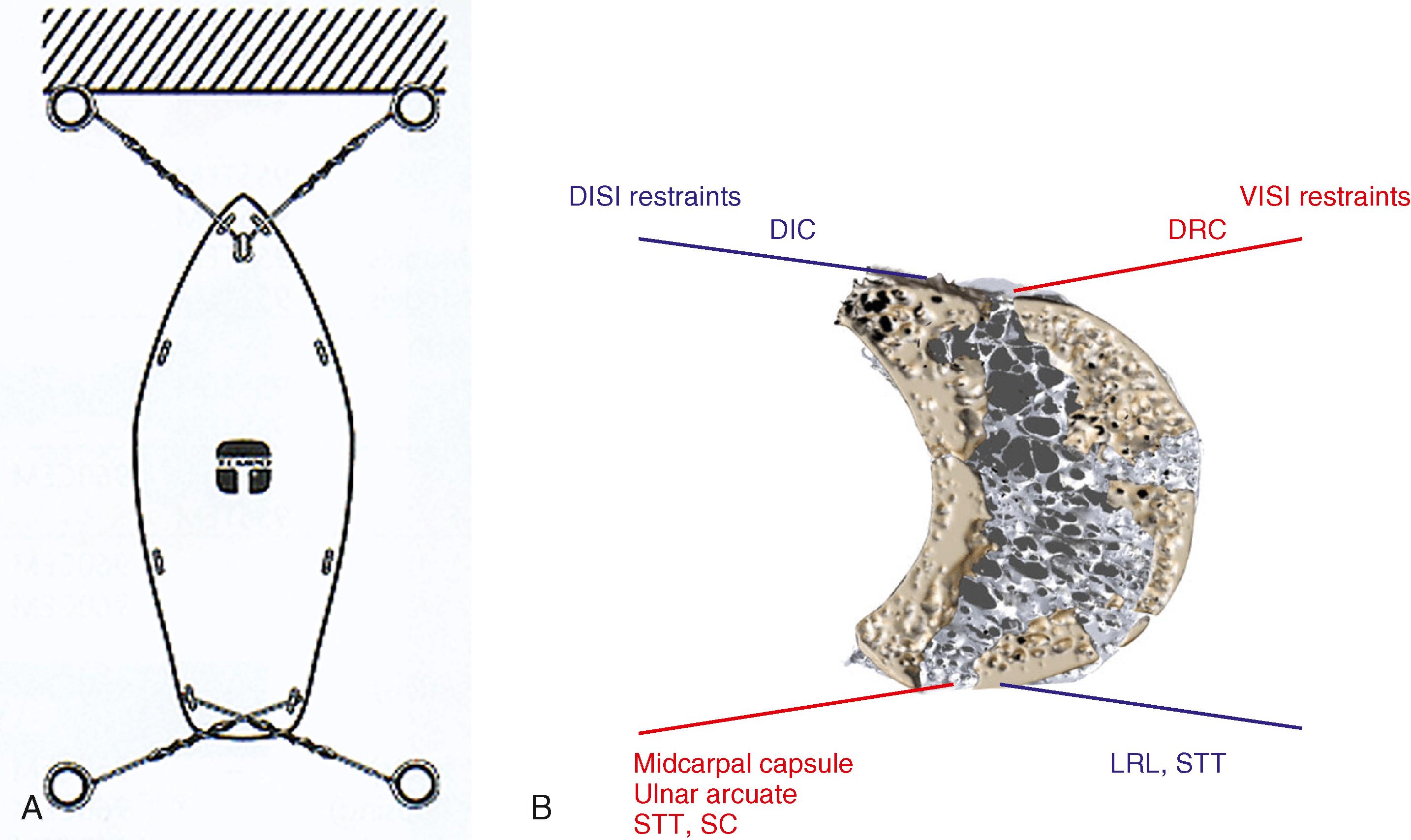
In theory, assuming the intrinsic and extrinsic ligaments are fully intact, the flexion tendency of the scaphoid and the extension tendency of the triquetrum under heavy or sudden loads would be neutralized, and carpal stability achieved. In practice, these ligaments cannot do this alone, as the tensile forces generated by many hand activities are too high for ligaments to be the only carpal stabilizers. To prevent injury under high load, ligaments need to be protected by neuromuscular stabilization. , ,
To ensure a timely and protective muscle response, the carpal ligaments play an essential role in coordinating a centralized musculoligamentous response to abnormal wrist loads through mechanoreceptors, which provide the proprioceptive information required by the sensorimotor system to activate that response. In this view, the “helical antipronation ligaments” (HAPL) are coiled around the scapholunocapitate joint in such a way as to provide a first line of defense against instability, sensing application of load, pronation torque of the distal carpal row, and scaphoid flexion. Reflex activation of stabilizing antipronation muscles (ECRL, APL, FCU) provides powerful stabilization.
Until recently, muscles were considered to have a negative influence on carpal stability. Instability was assumed to be a ligament insufficiency problem made worse by muscle contraction. Now we know that the assumption is wrong: Muscles play an important stabilizing role , , ( Fig. 13.12 ).
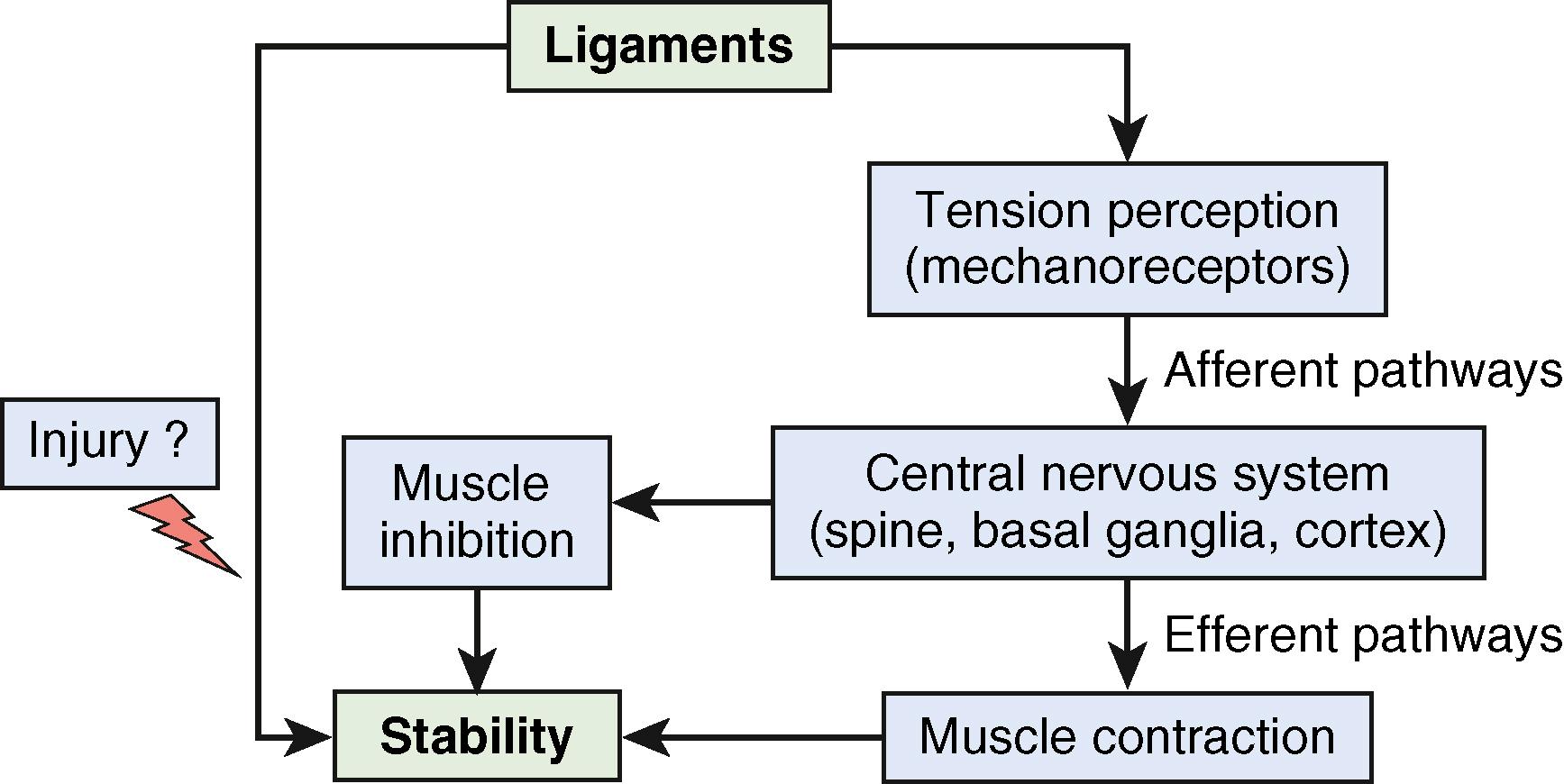
The mechanisms of muscle stabilization of the wrist are based on the previously mentioned ability of some muscles to actively pronate or supinate the distal carpal row, thus counteracting or balancing applied loads. , When the distal row supinators (ECRL, APL, FCU) contract, the trapezium displaces dorsally, thus tensioning the STT ligament. If the STT ligament is intact, the scaphoid cannot collapse into flexion and pronation. The intracarpal supinators, therefore, protect against excessive flexion-pronation of the scaphoid ( ![]() ). In contrast, when the ECU or FCR contracts, the distal row pronates, tightening the TqH ligament and preventing the proximal row from collapsing into VISI in cases of lunotriquetral insufficiency or dissociation. As a distal row pronator, the role of the FCR in proximal row stability is controversial because distal row pronation stresses the SL relationship ( ). Recent cadaveric studies of the intact carpus demonstrate that activation of the FCR when the wrist is in neutral or extension actually supinates the scaphoid through a dorsolateral vector at the scaphoid tubercle, thus compressing the SL joint. Thus, strengthening and activation of the distal row and scaphoid supinators may be useful in the nonoperative treatment of scaphoid rotatory instability and the intracarpal pronators in the treatment of LT instabilities.
). In contrast, when the ECU or FCR contracts, the distal row pronates, tightening the TqH ligament and preventing the proximal row from collapsing into VISI in cases of lunotriquetral insufficiency or dissociation. As a distal row pronator, the role of the FCR in proximal row stability is controversial because distal row pronation stresses the SL relationship ( ). Recent cadaveric studies of the intact carpus demonstrate that activation of the FCR when the wrist is in neutral or extension actually supinates the scaphoid through a dorsolateral vector at the scaphoid tubercle, thus compressing the SL joint. Thus, strengthening and activation of the distal row and scaphoid supinators may be useful in the nonoperative treatment of scaphoid rotatory instability and the intracarpal pronators in the treatment of LT instabilities.
Two mechanisms of injury may result in carpal dysfunction: direct and indirect. In the first, a force is applied directly to the carpus, whereas in indirect mechanisms, the deforming load is initially applied at a distance from the injured joint. In the latter, the tensile forces are usually transmitted by ligaments and compressive forces are transferred by the adjacent articular surfaces.
A typical direct mechanism of carpal instability occurs when the transverse carpal arch is crushed by a power press or a wringer-type machine. Another is the injury produced by an explosion. In both of these cases, the dislocating force is applied over a wide surface area of the wrist, creating a global disruption, often following a typical axial dislocation pattern. By contrast, when the force is exerted over a small area of the wrist, a localized ligament rupture, dislocation, or fracture-dislocation may occur. ,
Most dorsal perilunate dislocations are the result of an indirect mechanism of injury, usually an extreme extension of the wrist, associated with variable degree of ulnar deviation and midcarpal supination, often owing to violent trauma such as that sustained in falls from heights or in motorcycle accidents. Although fractures of the distal radius may accompany a perilunate dislocation, such a combination is not common. Several factors may explain the occurrence of one or another type of injury, including age-related differences in bone stock; differences in direction, rate, and magnitude of the deforming forces; differences in position of the wrist at the time of impact; and so forth.
In an effort to understand both the sequence of injury and the progression of ligamentous damage, Mayfield and colleagues undertook several cadaver studies. Their findings confirmed that most carpal dislocations around the lunate (a broad spectrum of injuries ranging from minor SL sprains to a complete palmar dislocation of the lunate) are the consequence of a similar pathomechanic event, the so-called progressive perilunate instability. Four stages of progressive carpal destabilization have been identified ( Fig. 13.13 ).
Stage I: SL Dissociation/Scaphoid Fracture: When the distal carpal row is forced into hyperextension by an external force, the palmar midcarpal STT and SC ligaments become increasingly taut. This creates a progressive extension moment to the scaphoid, which is transmitted to the lunate via the SL ligaments. The lunate, however, is tightly constrained by the long and short RL ligaments. Such an increasing torque may result in a progressive tearing of the SL interosseous membrane and ligaments, from palmar to dorsal, eventually leading to complete SL dissociation (SLD). If, by contrast, the same process occurs when the wrist is somewhat radially deviated, not only the lunate but also the proximal pole of the scaphoid is strongly constrained by the RSC ligaments. In such circumstances, instead of an SLD, a fracture of the scaphoid is likely. Rarely, hyperextension neither results in scaphoid fracture nor in SLD but creates a more distal dissociation at the scaphoid-trapezium level.
Stage II: LC Dislocation: Once the SL joint is disrupted, or the scaphoid fractured, if wrist extension increases, the distal row may translate dorsally and dislocate relative to the lunate, or a capitate fracture may appear and its distal portion dislocate dorsally with the rest of the distal row. The head of the capitate remains behind, and may rotate 180 degrees (scaphocapitate syndrome). In both instances, displacement of the distal row may be associated with a detachment of the RSC ligament off the radial styloid. As a consequence of the dislocation, a curved capsular rent across the space of Poirier appears, through which the midcarpal joint is exposed palmarly.
Stage III: LT Disruption/Triquetrum Fracture: As the capitate displaces dorsally, the THC ligamentous complex becomes tensed, creating both an extension moment and a dorsal translation vector to the triquetrum. Such forces may result either in the separation of the triquetrum from the lunate, secondary to rupture of the LT ligaments, or a sagittal fracture of the triquetrum.
Stage IV: Lunate Dislocation: When all perilunate ligaments are torn, only the dorsal capsule and palmar RL ligaments can hold the lunate in place. In such circumstances, the dorsally displaced capitate may exert a palmar translation force to the dorsum of the lunate, resulting in a palmar lunate extrusion. Such dislocation is often associated with a variable degree of palmar rotation into the carpal tunnel. Depending on the amount of lunate rotation, stage IV has been subdivided into three categories: (1) lunate dislocation type I, where the lunate exhibits a minor rotation (less than 90 degrees); (2) lunate dislocation type II, where the lunate is rotated more than 90 degrees around an intact, undisrupted, palmar capsule (short RL ligament); and (3) lunate dislocation type III, which is complete enucleation of the lunate with rupture of the palmar capsule.
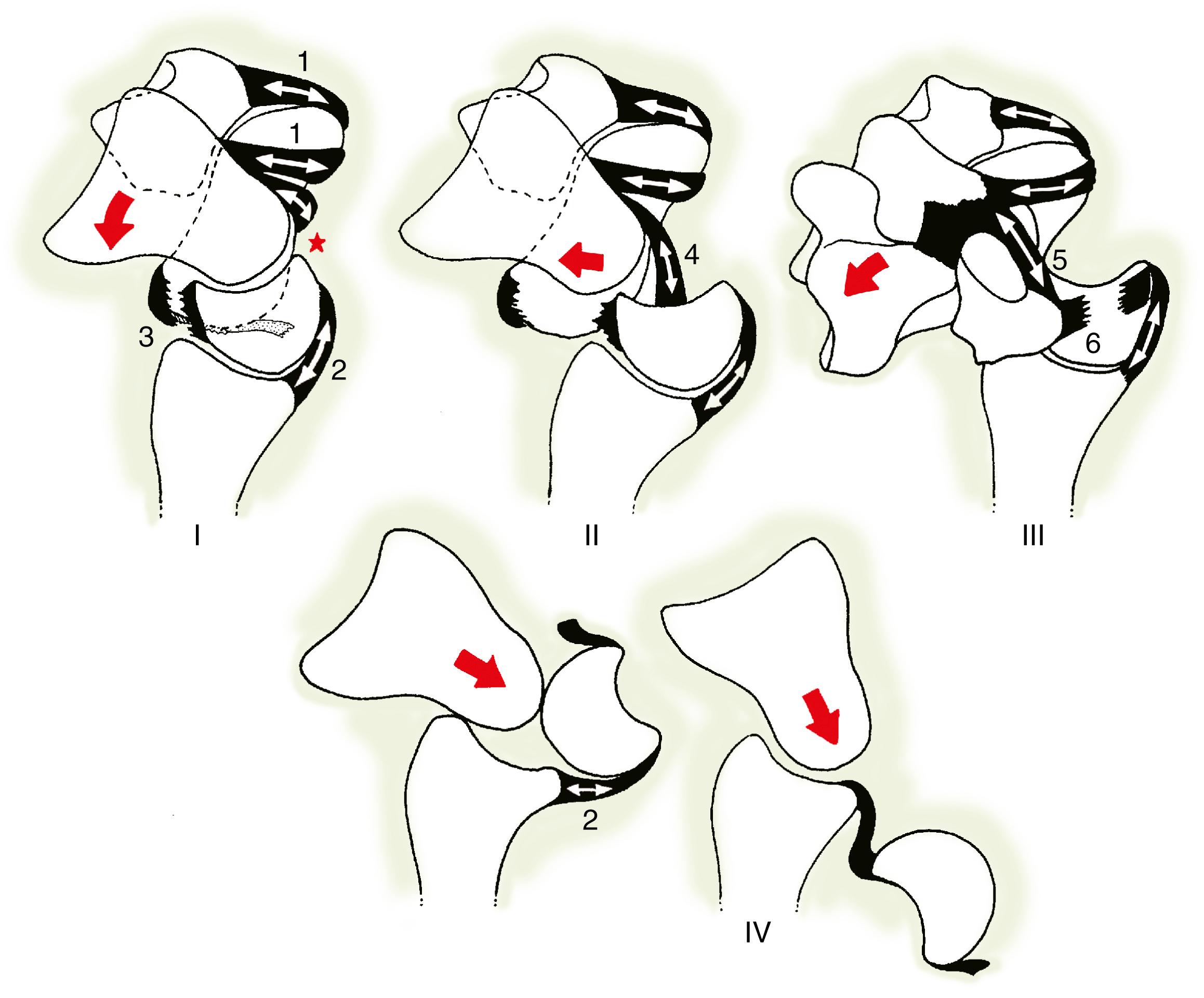
Rarely, the carpal dissociation starts at the ulnar side and proceeds radially around the lunate in a “reverse perilunate instability pattern.” The mechanism is thought to occur as a result of a backward fall on the outstretched hand with the upper limb externally rotated. In such circumstances, high load is applied to the hypothenar area, the triquetrum being forced by the pisiform to displace dorsally relative to the lunate. Since the lunate is constrained by the radius, complete rupture of the LT ligaments occurs (stage I); followed by UL, UT, and UC ligament rupture and LC dislocation (stage II) and completed with SLD and RSL rupture, enabling reverse dorsal perilunate dislocation (stage III). This mechanism was elucidated in 16 cadaveric wrists by Murray et al. in an extension-radial deviation sequence.
Injuries to the wrist that result in transient or permanent carpal malalignment have long been recognized in the medical literature. Gilford et al., in 1943, described the scaphoid as an essential “bridge” that stabilized the link joint of the radius, lunate, and capitate, which would otherwise “crumple” under load. In 1970, Fisk was the first to use the term “carpal instability,” to describe a zigzag pattern of carpal malalignment present in some patients with fractured scaphoids. The 1972 landmark paper by Linscheid and coworkers helped popularize this condition by coining and defining the terms “dorsal intercalated segment instability” (DISI) and “volar intercalated segment instability” (VISI) ( Fig. 13.14 ). For reasons stated earlier, it is important that the term instability not be used exclusively as a synonym for malalignment, but rather be used to describe those symptomatic patients whose carpal bones move abnormally under load.
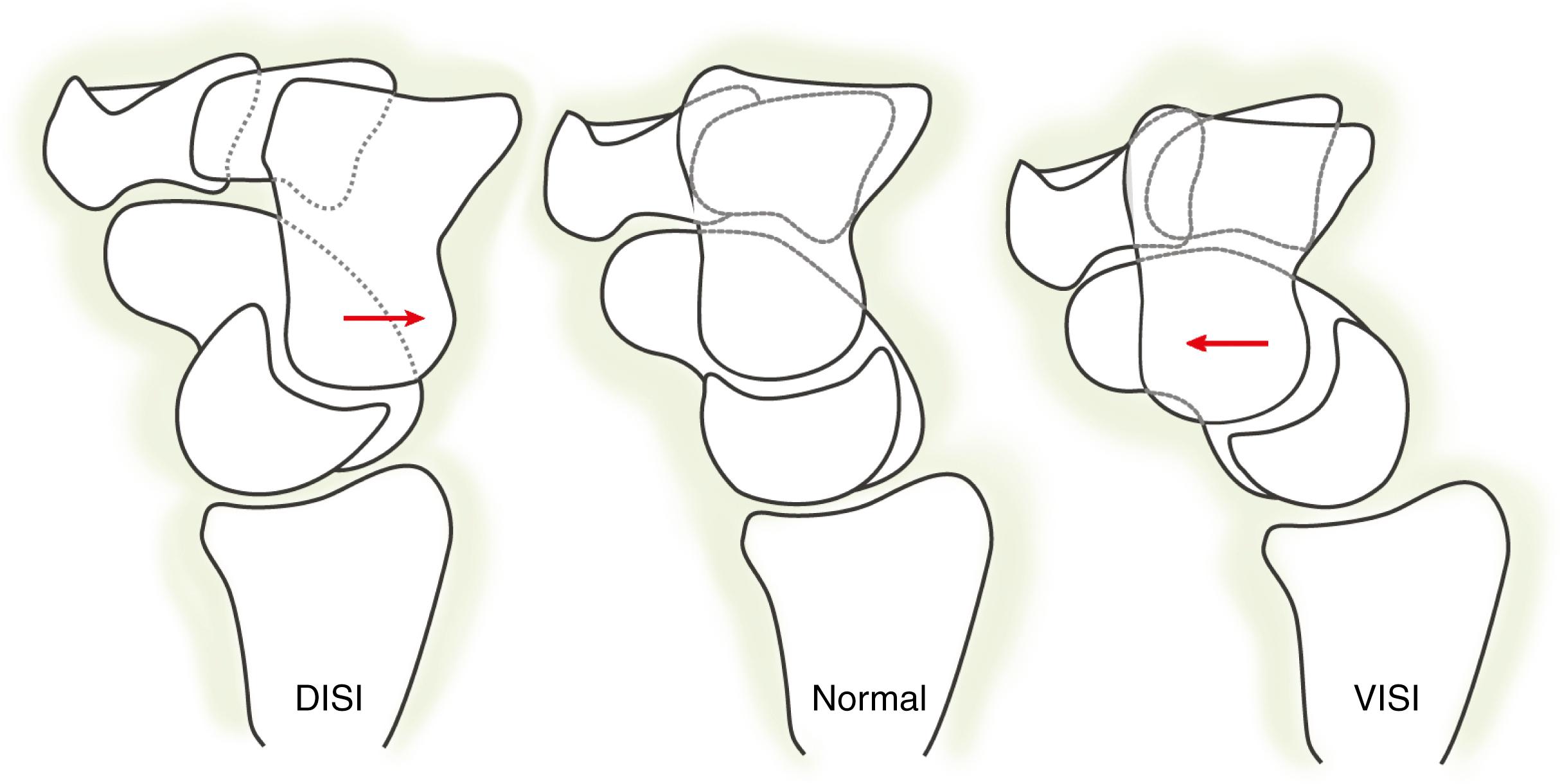
From a mechanical point of view, stability is defined as the ability of a joint to maintain a normal relationship between the articulating bones under physiologic loads throughout its ROM. According to this definition, a wrist joint should be considered unstable when it is not capable of preserving a normal kinematic and kinetic connection between the radius, carpal bones, and metacarpals. Hence, stability implies both the ability to transfer functional loads without yielding or losing its internal joint congruency and the capacity to maintain motion throughout its range without sudden alterations of intercarpal alignment.
From this point of view, a grossly malaligned wrist with degeneration of the articular cartilage may be able to bear substantial loads; however, because it cannot experience smooth, painless motion and because certain motions or loads are painful, it fulfills the criteria of carpal instability. Similarly, a wrist with a ligament disruption may have a completely normal carpal alignment when unloaded; however, if it is incapable of sustaining functional loads without experiencing abrupt changes in the alignment of the carpal bones, it must be regarded as unstable.
Based on this definition, carpal instability may result from a wide spectrum of injuries or diseases. Congenital anomalies such as Madelung deformity, scaphoid hypoplasia, and avascular necrosis, as well as infections, inflammatory arthritis, or carpal synostosis, may create abnormal conditions of carpal instability that eventually require specific treatment. Management of these nontraumatic carpal instabilities is discussed elsewhere. This chapter covers only traumatically induced carpal instabilities.
Many clinical conditions may eventually result in an unstable wrist. Classifying such diversity of conditions is not easy. Some classifications are based on the location of the predominant dysfunction. Others emphasize the direction of the abnormal alignment. Others classify instability according to its severity. Unfortunately, none of these classifications are exhaustive enough to allow categorization of all types of carpal instability, yet sufficiently simple to be easily remembered and used clinically. It is our opinion that the controversy about which classification is best is meaningless because none can be ideal. Instead, more effort should be spent in providing tools to help the clinician interpret the particular features of each individual case.
With that in mind, Larsen and colleagues devised a six-category analytic system to help the clinician assess patients with a history or clinical findings consistent with carpal instability ( Table 13.2 ). While not a classification system per se, the authors propose that consideration of each category will allow any instability pattern to be uniquely characterized and recorded, facilitating clinical reporting and ultimately treatment and prognostic recommendations.
| Category I: Chronicity | Category II: Constancy | Category III: Etiology | Category IV: Location | Category V: Direction | Category VI: Pattern |
|---|---|---|---|---|---|
| Acute, >1 week (maximum primary healing potential) Subacute, 1 to 6 weeks (some healing potential) Chronic, >6 weeks (little healing potential) |
Occult Dynamic Static reducible Static irreducible |
Congenital Traumatic Inflammatory Neoplastic iatrogenic Miscellaneous |
Radiocarpal Proximal intercarpal Midcarpal Distal intercarpal CMC Specific bones |
VISI rotation DISI rotation Ulnar translation Dorsal translation Other |
Carpal instability dissociative (CID) Carpal instability nondissociative (CIND) Carpal instability complex (CIC) Carpal instability adaptive (CIA) |
The first three categories are prognostic, including the relative chronicity of the injury (acute, subacute, or chronic); the severity of the injury (dynamic, static, or fixed); and the etiology (traumatic, congenital, acquired, etc.). The next two are radiographic and describe the involved joints or carpal bones as well as the direction of malrotation (dorsal, volar, ulnar). The final category is descriptive, based on classes of instability (dissociative, nondissociative, complex, or adaptive). The authors’ goal to provide an “exhaustive system” to describe a wide variety of conditions was met, and it is critical that each category be considered in the evaluation and management of each patient with carpal instability. The system is not, however, fully inclusive and as such has not been readily incorporated into clinical outcome studies. It is not possible, for instance, to categorize a patient with chronic reducible dissociative DISI pattern with dorsal scaphoid translation into “proximal intercarpal,” “radiocarpal,” or “midcarpal,” as all three joints and their corresponding ligaments are involved.
For the traumatic instabilities reviewed in this chapter, the sixth category is particularly important to examine and understand, as there are four major instability patterns of the wrist ( Table 13.3 ). The first group includes the so-called dissociative carpal instabilities, also known as carpal instability dissociative (CID), in which the predominant dysfunction (i.e., ligament rupture or insufficiency) occurs between bones of the same carpal row. , Most CIDs occur between the scaphoid and lunate and less often between the lunate and triquetrum. Dissociative instabilities seldom occur between the bones of the distal carpal row, as there is little mobility between them.
| Pattern | Subtype | Features |
|---|---|---|
| Carpal instability dissociative (CID) | Scapholunate dissociation | Rotatory subluxation Scapholunate diastasis Dorsal scaphoid translation DISI |
| Lunotriquetral dissociation | LT dissociation VISI |
|
| Carpal instability nondissociative (CIND) | Radiocarpal | Dorsal, ulnar, volar |
| Combined midcarpal/radiocarpal | VISI, DISI | |
| Traumatic proximal row | VISI, DISI | |
| Midcarpal | CLIP, CCI | |
| Carpal instability complex (CIC) | Carpal dislocations | Radiocarpal/intercarpal |
| Combined intercarpal/radiocarpal | Type 2 ulnar translocation | |
| Axial disruptions of the carpus | Axial-ulnar Axial-radial Axial-radial-ulnar |
|
| Carpal instability adaptive (CIA) | Distal radius malunion Neuromuscular conditions |
VISI, DISI nondissociative |
The second group includes the nondissociative carpal instabilities, also known as carpal instability nondissociative (CIND). , , , This group includes radiocarpal, midcarpal, and combined radiocarpal-midcarpal (or proximal row) instabilities. If the entire carpus is translocated with respect to the radius in any direction, this is radiocarpal instability. , If the proximal carpal row as a unit collapses and becomes unstable, either in flexion or extension, this is a combined radiocarpal and midcarpal instability, a condition that is more concisely termed nondissociative instability of the proximal carpal row, or more simply, proximal row instability. , While most frequently associated with ligament laxity, a severe, posttraumatic variety of CIND has recently been described, associated with acute fractures of the radius , or scaphoid. , Less frequently, there are cases (e.g., capitolunate instability pattern [CLIP]) where there is only a dysfunction at the midcarpal level, the radiocarpal joint being uninvolved, and the proximal carpal row aligned normally. The authors recommend that only these rare cases be referred to as “midcarpal” instabilities.
The third group of instabilities is formed by the so-called carpal instability complex (CIC), where there are features of both CID and CIND types. Carpal dislocations, if treated inadequately, may generate complex (i.e., CIC) patterns of instability where the dysfunction affects both the radiocarpal and the proximal row intercarpal joints. With time, however, the untreated or incompletely reduced carpal derangement may evolve into a stiff malaligned joint. Dissociative instabilities between the columns of the wrist are rare, involving bones of the proximal and distal carpal rows, and by necessity the radiocarpal, intercarpal, and midcarpal joints. These are usually the result of a violent dorsopalmar crushing mechanism. These complex dissociative injuries present as axial disruptions of the carpus and are analogous to Lisfranc fracture-dislocations of the midfoot.
The final group, or “carpal instability adaptive” (CIA), refers to cases of carpal malalignment not secondary to an intercarpal injury or radiocarpal/midcarpal ligamentous injury, but rather to a condition outside of the carpus. The most frequent type of CIA is the carpal malalignment that occurs when an otherwise normal carpus adapts to a malunited, nonarticular distal radius fracture. The entire proximal carpal row follows the malunited articular surface and remains aligned with it, producing an apparent DISI or VISI deformity with respect to the shaft of the radius. The proximal row is also malaligned with respect to the distal carpal row, which is aligned with the metacarpals. It is important to note that the interosseous relationships of the proximal row remain normal and that patients are generally asymptomatic with respect to their carpal malalignment. These malalignments frequently reduce when the deformity is recognized and treated promptly, but may persist in chronic or neglected cases. Neuromuscular conditions (cerebral palsy, stroke) can also create an imbalance of forces (through disruption of normal sensorimotor pathways) that leads to postural deformities of the proximal carpal row. Further discussion and treatment of adaptive carpal instability patterns will be discussed in Chapter 15, Chapter 32 .
Patients with wrist disorders present in a spectrum of ways, ranging from the atraumatic to those involved in high-energy trauma such as a motor vehicle accident. Accurate diagnosis of their condition is critical to prevent carpal dysfunction. The mnemonic SCARCE may be helpful when assessing patients with wrist dysfunction and suspected carpal instability.
S for integrity of the critical s tabilizers
C for c arpal alignment
A for a cuity of injury (acute, subacute, or chronic)
R for r educibility of the carpus
C for the status of the articular c artilage (healthy versus degenerative)
E for the e xtent of the ligament injury (partial versus total or volar versus dorsal versus complete tear)
The natural inclination to study radiographs or special imaging studies and reports prior to a thorough history and physical examination should be avoided, as this introduces cognitive bias, which can affect one’s thinking and decision making. Doing so may save time in the short term but may lead to diagnostic and treatment errors. Similarly, physical examination always needs to be preceded by a thorough investigation of the patient’s medical history, with special emphasis on the mechanism of injury and acuity. The patient should be asked details about the location, duration, and characteristics of any pain, including aggravating and relieving factors and previous treatments, if any. With chronic problems, it is also important to inquire about the patient’s jobs and hobbies, and whether there has been exposure to repetitive stress, vibrating tools, or potentially dangerous instruments. Elucidating a history of ligamentous laxity or multiple joint instabilities, especially in younger patients presenting with chronic wrist pain, is also important. Such an evaluation should also include an assessment of their stress coping skills.
Except in cases with an open dislocation, the external appearance of most wrist dislocations may not be dramatic. Swelling is generally moderate, and bone displacements may be evident only if the patient is seen immediately after experiencing trauma. If there has been a delay since the accident, swelling may have increased substantially, making visualization of the displaced bones more difficult. When present, skin abrasions, contusions, or ecchymosed areas may be helpful in determining the mechanism of injury and the potential areas of damage.
ROM is usually limited by pain in acute injuries, whereas it may be reduced or normal in more chronic cases. In the latter, passive assessment of mobility is valuable not only in determining the presence of abnormal motion or crepitus but also in reproducing the patient’s pain. The physician should also record the motion in the contralateral, uninjured wrist for comparative purposes.
Palpation for areas of maximal tenderness is one of the most useful tools in the diagnosis of wrist pathology, especially in patients with chronic dysfunctions. , In acute dislocations, because of extensive soft tissue damage, tenderness is seldom elicited at specific points but rather in a diffuse manner. Nonetheless, palpation should always be performed in a methodical way, starting from the basal joint of the thumb and proceeding across the proximal carpal row from the scaphoid to the triquetrum and continuing from the hamate (and its hook) back across the distal row and CMC joints, ending with provocative clinical maneuvers as needed (see below).
A careful assessment of neural and vascular status is imperative, with particular attention being paid to the median and ulnar nerves, which may be injured by direct contusion at the moment of impact, by compression from displaced bones or by swelling within the carpal canal.
A thorough set of provocative maneuvers should be performed, not just to concentrate on the suspected diagnosis but specifically to rule out alternative or even concurrent diagnoses. More complete descriptions of these tests follow in each treatment section. One’s examination should be methodical and follow a routine so that all potential diagnoses are considered. In general, starting in an area away from the point of maximal tenderness is an ideal way to gain a patient’s confidence and to avoid emotional reaction or withdrawal, which may preclude a thorough examination. In a fashion similar to palpation, the examination should begin in a nontender area and proceed rotationally around the carpus, ending at the most symptomatic area. A typical examination would begin at the radial column, with an assessment of stress instability of the thumb basal joint, moving to Watson’s scaphoid shift test at the scaphoid tubercle (page 509), Finkelstein and Eichhoff maneuvers for first dorsal compartment tendinopathy ( Chapter 56 ), and manually resisted flexion/radial deviation of the wrist to test for flexor carpi radialis tendinitis ( Chapter 56 ). The examination then proceeds to ballottement and shear tests for LT instability (page 510). Tendinopathy of the ECU is ruled out with the synergy test ( Chapter 56 ), and frank ECU instability with supination while maximally flexed and ulnar deviated ( Chapter 14 ). The TFCC must be carefully examined, and the distal radioulnar joint must be assessed for instability in neutral, supination, and pronation. Ulnar impaction and ulnar styloid impingement must be assessed in pronation and supination, and osteoarthritis by compression testing ( Chapter 14 ). Finally, resisted ulnar flexion can help rule out FCU tendinopathy and accompanied by a pisotriquetral “shuck” test for synovitis or osteoarthritis. Nondissociative instability of the carpus is next assessed with Lichtman’s midcarpal shift test and the associated “catch up clunk” (page 539), as well as Louis’ CLIP maneuver for midcarpal instability (page 542). This examination is by no means comprehensive, but performance of such a routine on normal and injured wrists will increase the examiner’s diagnostic expertise.
Bilateral grip and pinch strength are useful to uncover underlying pathology in chronic cases. Strength may be diminished due to muscle atrophy, pain inhibition, or learned behaviors. Rapid alternating grip assessment may be helpful in determining voluntary effort. A local injection of anesthetic to a painful joint or selected tendon sheath may help normalize the dynamometer readings and narrow the diagnostic spectrum. Sensory testing should always accompany an examination of suspected nerve compression, using threshold (Semmes Weinstein or von Frey monofilaments) or density testing (static and moving two-point discrimination) (see Chapter 28 ).
Patient-reported (or patient-related, patient-rated) outcome measures (PROMs) represent a rapidly expanding field that complements our assessment and diagnostic abilities and provides a rich database of information for clinical research and outcome studies. The emergence of electronic medical records has facilitated our collection and storage of these instruments, in some cases automating interval updates or providing broad intake information for new patient visits. Regular collection of PROMs is essential for clinical research, but whether one practices in academia or not, PROMs also enable an introspective examination of one’s decision making and treatment of different conditions. Newer instruments such as the PROMIS allow “conditional navigation” tools that narrow the range and number of questions dependent on a patient’s particular symptoms or condition. The DASH, MHQ, PRWHE, and PROMIS outcome measures are examples of some of the more widely used wrist and hand outcome scales, but a full review of these is beyond the scope of this chapter.
The initial radiographic examination of a patient with a suspected carpal injury should include at least four images of the wrist including a PA, lateral, scaphoid (PA in ulnar deviation and supination), and a 45-degree pronated oblique view. Contralateral wrist radiographs are an essential part of the workup for suspected ligament injury.
The PA view should be obtained with the hand placed flat over the radiograph film, the shoulder abducted 90 degrees, the elbow flexed 90 degrees, and the forearm in neutral rotation. One can determine whether it is a true PA radiograph by checking that the ECU groove is seen radial to the ulnar styloid. In the PA view of a normal wrist, the proximal and distal outlines of the proximal row, as well as the proximal outline of the distal row (i.e., “Gilula’s lines”), are smooth, without breaks in their continuity ( Fig. 13.15 ). Any step-off of these lines indicates abnormality at the site where the arc is broken. In addition, the ulnar styloid should form the ulnar border of the ulna.
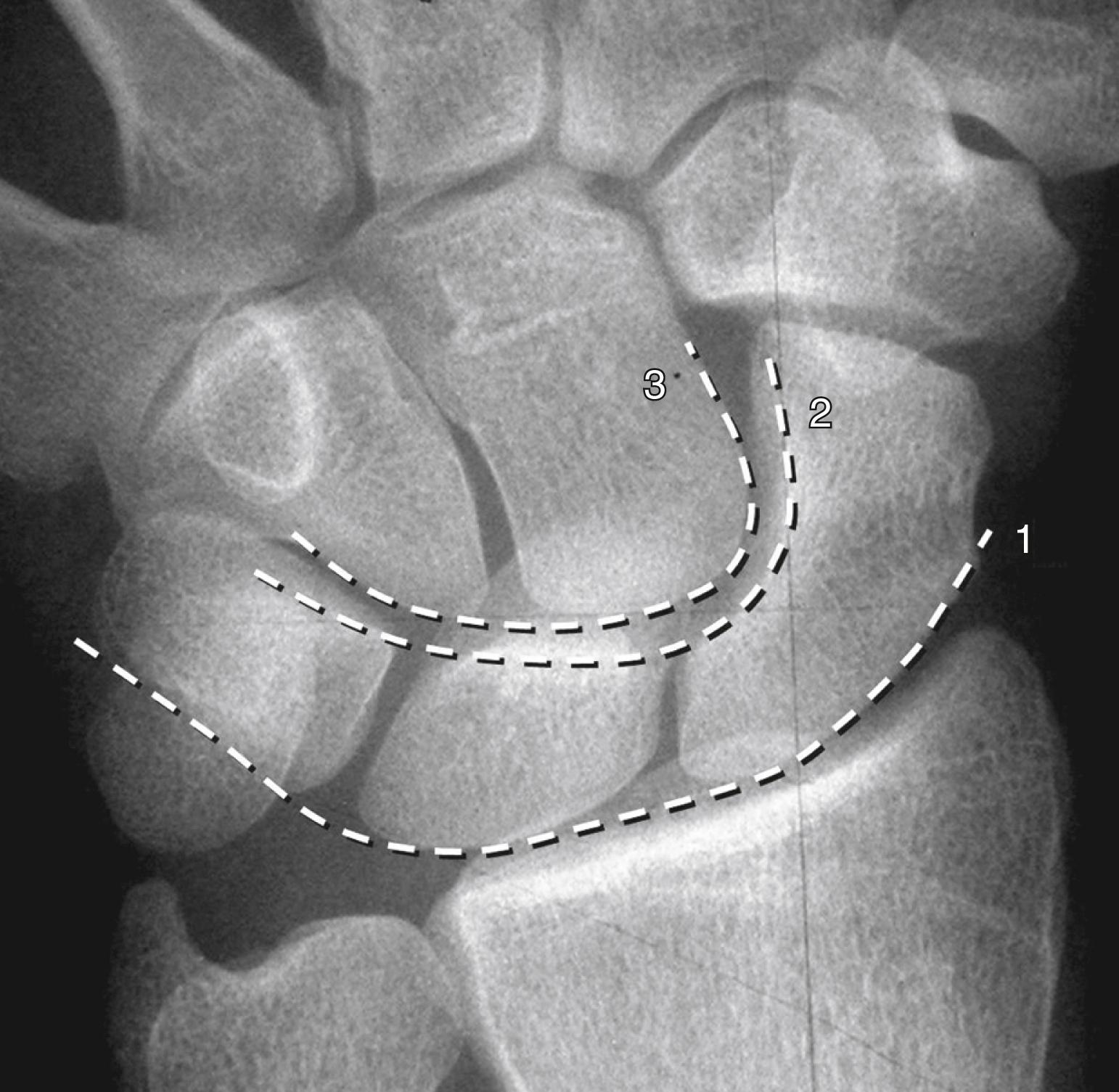
The articulating carpal bones have parallel opposing surfaces separated by 2 mm or less. Any overlap between well-profiled carpal bones identifies an intercarpal abnormality and should prompt further imaging ( Fig. 13.16 ). Joint diastasis should not be interpreted as a sign of joint disruption unless it is compared with the uninjured, contralateral side.

In the PA view of a wrist in neutral, the normal lunate has a trapezoidal configuration. It is possible to differentiate a flexed from an extended lunate based on the shape of its contour (see Fig. 13.16 ). To do so, it is important to remember that, in the transverse plane, the lunate is wider palmarly than dorsally. Therefore, when abnormally extended, the lunate has an ovoid configuration due to the distal displacement of the wider anterior horn. Conversely, when abnormally flexed the lunate is triangular shaped, often with a half moon–like configuration, with its concavity facing toward the scaphoid. ,
The lateral view must be taken with the arm adducted to the patient’s side, and with both the forearm and the wrist in neutral rotation. For a lateral projection to be correct, the axis of the third metacarpal needs to be parallel to that of the radius, and the palmar outline of the pisiform needs to be located between (and equidistant to) the palmar surfaces of the scaphoid tuberosity and the capitate head.
The best projection to confirm a scaphoid fracture is a PA view centered on it, with the wrist in ulnar inclination, slightly supinated, and the fingers fully flexed.
A lateral radiograph with 45 degrees of pronation profiles the anterolateral and posteromedial corners of the carpus and is useful to identify fractures of the dorsal ridge of the triquetrum and of the scaphoid tuberosity.
When routine radiographs do not confirm the suspected diagnosis, obtaining additional views may be needed. The following are the most commonly used projections for the wrist.
Anteroposterior (AP) (palm up) view with a clenched fist: If an SL ligament injury is suspected, obtaining a fully supinated clenched fist view may accentuate the gap that often appears with this injury by axial-directed force to the carpus through the capitate ( Fig. 13.17A ). It is preferable to obtain this view in a neutral wrist posture. Correct positioning can be objectively evaluated by looking at the third CMC joint. When the wrist is in neutral, the joint’s surfaces are parallel. Contralateral stress views of the wrist may be of benefit when a suspicion of dynamic instability is suspected.
![Fig. 13.17, A, Schematic representation of the most frequent displacements (red curved arrows) exhibited by an SL dissociation under axial load in a supinated AP grip radiograph (white arrow) : The scaphoid tends to rotate into flexion and slight pronation; the unconstrained triquetrum and lunate extend (dorsal intercalated segment instability [DISI]); the distal carpal row pronates and a gap appears between the scaphoid and lunate (yellow double arrow) . B, The scapholunate space is clearly shown in a PA pronated view with the tube angled 10 degrees from the ulnar side. The gap is measured in its midportion, the landmark being the middle of the flat medial facet of the scaphoid (arrows) . C, PA pronated view of an injured and symptomatic wrist demonstrating no appreciable scapholunate gap. D, Bilateral pronated “pencil grip” PA view of the same patient demonstrating dramatic widening of the injured scapholunate interval under load, and with the joint profiled by this view’s increased pronation. Fig. 13.17, A, Schematic representation of the most frequent displacements (red curved arrows) exhibited by an SL dissociation under axial load in a supinated AP grip radiograph (white arrow) : The scaphoid tends to rotate into flexion and slight pronation; the unconstrained triquetrum and lunate extend (dorsal intercalated segment instability [DISI]); the distal carpal row pronates and a gap appears between the scaphoid and lunate (yellow double arrow) . B, The scapholunate space is clearly shown in a PA pronated view with the tube angled 10 degrees from the ulnar side. The gap is measured in its midportion, the landmark being the middle of the flat medial facet of the scaphoid (arrows) . C, PA pronated view of an injured and symptomatic wrist demonstrating no appreciable scapholunate gap. D, Bilateral pronated “pencil grip” PA view of the same patient demonstrating dramatic widening of the injured scapholunate interval under load, and with the joint profiled by this view’s increased pronation.](https://storage.googleapis.com/dl.dentistrykey.com/clinical/CarpalInstability/16_3s20B9780323697934000134.jpg)
PA (palm down) view with 10 degrees of tube angulation from ulna toward radius: This view is ideal to assess the SL interval. Measurement of its separation (SL gap) is made at the midportion of the joint where its anatomy is more consistent. The spacing should be compared with the opposite wrist and with the surrounding carpal articulations (see Fig. 13.17B ).
Clenched-pencil PA view: This is one of the best ways to demonstrate SLD because it optimally profiles the joint while it is being separated with some grip force. It consists of a PA view of both wrists while the two hands are gripping a pencil tightly, with the index fingers apposed and the thumb metacarpals lying flat on the radiographic cassette (see Fig. 13.17C and D). The technique provides comparison views of both wrists. ,
Oblique view at 20 degrees of pronation from the lateral position: This view is used to visualize the dorsum of the triquetrum, where avulsion fractures frequently occur, and to evaluate the distal tuberosity and waist of the scaphoid. It is ideal for fracture-subluxations of the fifth CMC joint.
Oblique view at 30 degrees of supination from the lateral position: The pisotriquetral relationship is best seen with this view.
Lateral view with the wrist radially deviated: The palmar outline of the hook of the hamate can be seen on a lateral view with the wrist radially deviated and the thumb in maximal palmar abduction. It places the hook of the hamate between the bases of the first and second metacarpals.
Carpal tunnel view: By profiling the carpal concavity of the wrist, a clearer view of the hook of the hamate, the pisiform, and the palmar ridge of the triquetrum can be obtained. In patients with acute injuries or wrist stiffness, however, pain produced by extending the wrist may preclude this exam.
Static deviation views: For patients suspected of having carpal instability, a routine “motion” series may be needed to determine the mobility and reducibility of the carpus, and in particular, the lunate. It should include PA and AP views in radial and ulnar inclination, in addition to lateral views in extension and flexion. Actual motion assessment can be easily performed in these planes with fluoroscopy of the injured and uninjured wrist (see Fluoroscopy, page 505).
Carpal malalignment has traditionally been determined by measuring specific distances and angles on PA or lateral radiographs. , When interpreting these data, however, one must be aware that the normal ranges for these parameters are quite diverse. Also, reproducibility is low and small errors in rotational positioning of the hand at the time of radiograph exposure may result in substantial variation in angle determination. Larsen et al. demonstrated the highest intraobserver and interobserver reliability using a standardized technique, incorporating tangent lines of the scaphoid, lunate, and third metacarpal to determine interosseous angles ( Fig. 13.18 ).
Radiolunate (RL) angle: This gives objective evidence of the dorsal or palmar tilt of the lunate. The normal RL angle should be between 20 degrees volar and 15 degrees dorsal. , , This measurement is the best evaluation of DISI and VISI posture, but its utility can be compromised by radiographs without true neutral sagittal alignment and should always be checked against the opposite wrist.
SL angle: This angle, formed by a line tangential to the proximal and distal convexities of the scaphoid’s palmar aspect and that of the lunate, has been quoted in the literature as one of the major determinants of SLD. Normal values range from 30 to 70 degrees (average, 47 degrees). , , Although angles greater than 80 degrees indicate rotatory subluxation of the scaphoid, lower readings do not rule out SL disruption. Values less than 30 degrees are not unusual for patients with STT joint osteoarthritis or VISI.
RS angle: This angle is formed between a line along the longitudinal axis of the radius and a line from the proximal palmar and distal margins of the scaphoid. Normal values range from 35 to 65 degrees, with an average of 52 degrees.
Lunocapitate angle (LC): In theory, the long axes of the radius, lunate, capitate, and third metacarpal are colinear. In practice, this occurs in less than 11% of normal subjects. Even so, every attempt should be made to standardize the lateral film by ensuring that the long axis of the third metacarpal and radius are as close to parallel as possible and that neutral rotation has been achieved by aligning the pisiform and scaphoid tubercle. The axis of the lunate is a line perpendicular to a line connecting the palmar and dorsal lunate rims. The capitate axis is identified by connecting a point in the center of the convexity of its head to a point at the center of the third CMC joint. Because of the difficulty in identifying the true axis of the capitate, Larsen et al. defined a substitute method as the tangent to the dorsum of the third metacarpal. A normal CL angle should be 0 ± 15 degrees with the wrist in neutral.
Ulnar variance: Ulnar variance is usually measured on true (zero rotation) PA radiographs, obtained with the shoulder 90 degrees abducted, the elbow 90 degrees flexed, the forearm and wrist in the neutral position, and the central x-ray beam centered directly over the wrist. The usual way to assess ulnar variance is to measure the distance between two lines perpendicular to the longitudinal axis of the radius. One is tangential to the most distal point of the ulnar dome, and the other is tangential to the distal articular surface of the lunate fossa. When the ulna is shorter than the radius, the ulnar variance is negative, and when longer, it is positive. The radioulnar length relationship can also be assessed with a pronated grip film in cases of suspected ulnar impaction, which should increase ulnar variance, and should be done on each wrist for comparison.
Carpal height ratio: This measurement can be used to determine carpal collapse. The term carpal height refers to the distance between the base of the third metacarpal and the distal articular surface of the radius measured along the proximal projection of the axis of the third metacarpal. The ratio (carpal height ÷ length of third metacarpal) was found to be 0.54 ± 0.03 in normal wrists. Given that some wrist radiographs do not often include the entire third metacarpal, some authors have proposed using the length of the capitate instead (i.e., carpal height ÷ capitate length), with a normal range of 1.57 ± 0.05 ( Fig. 13.19A ). This method has greater accuracy than the original method and can be calculated on standard wrist films.
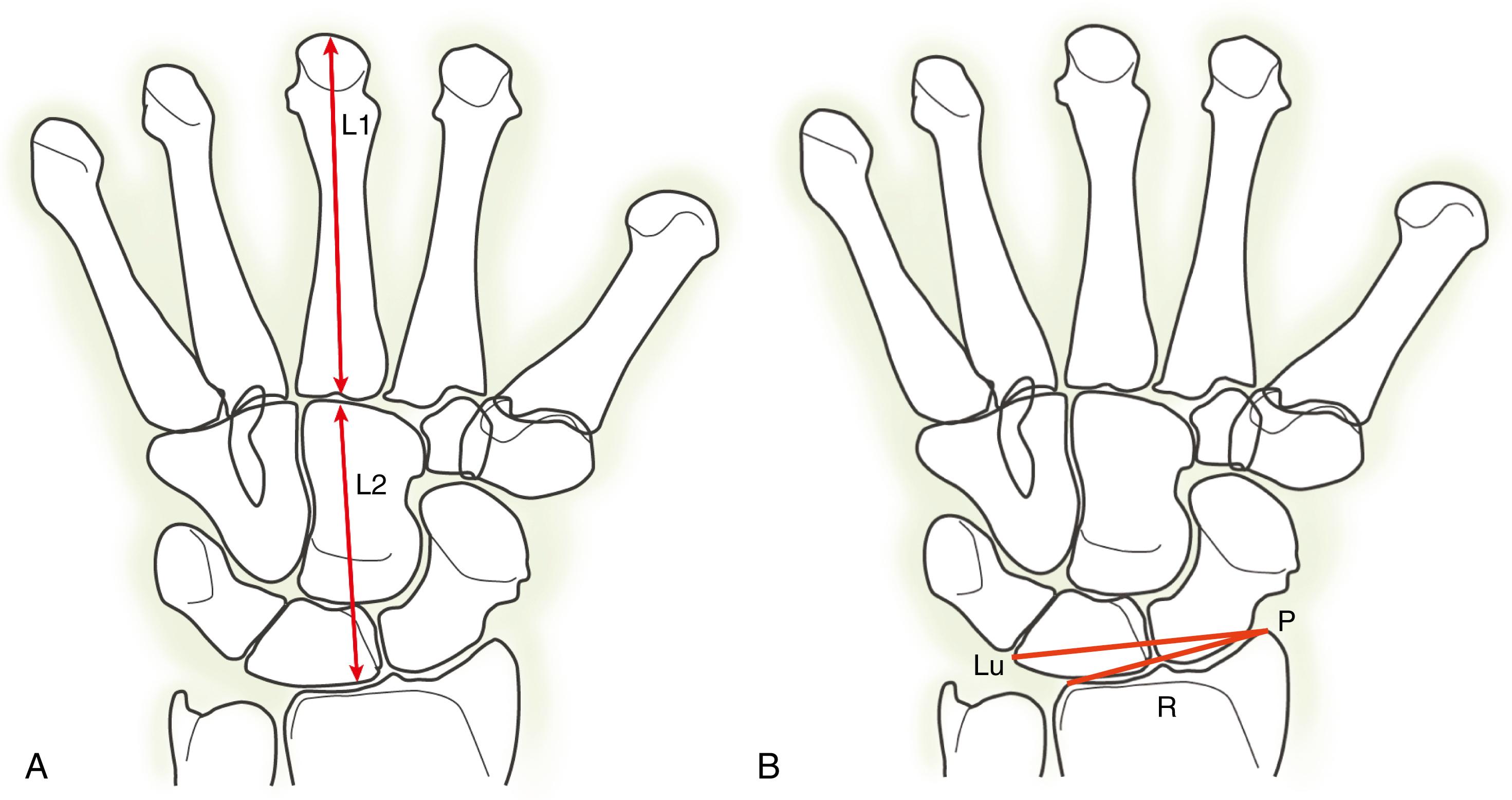
Ulnar translocation ratio: This measures the coronal displacement of the carpus and in particular the lunate. As described by Bouman and colleagues, a line measuring the length of the articular surface of the radius is divided by the distance from the radial styloid to the proximal ulnar corner of the lunate (see Fig. 13.19B ). Normal ratio is 0.87 ± 0.04.
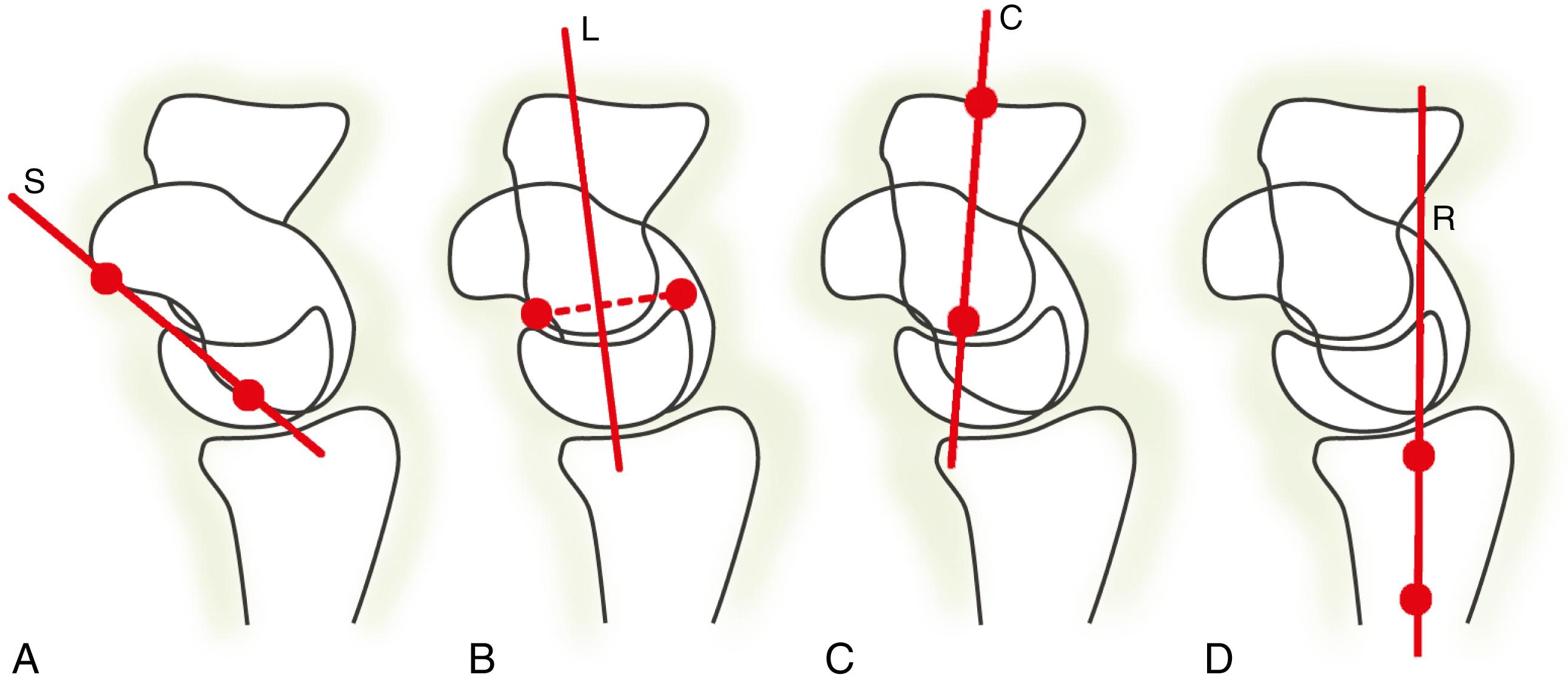
In patients with acute fracture-dislocations, the four routine views described earlier may be difficult to interpret because of overlapping and displaced carpal bones. In such cases, obtaining AP and lateral radiographs with the hand suspended in finger traps is recommended. Distraction views may reveal articular fracture fragments or an articular step-off that cannot be identified on routine films. Caution should be used when interpreting Gilula’s lines in patients with ligamentous laxity, and the contralateral wrist should be imaged for comparison.
Dynamic examination of the moving wrist may provide considerable information for the evaluation of patients with altered kinematics (“clunking” wrists) whose radiographs are otherwise normal. The technique involves the use of an image intensifier during active wrist motion from a radial-to-ulnar direction in the frontal and sagittal projections, and flexion and extension in the sagittal projection. If the patient has a painful clunk, the nature and direction of the subluxation can be identified. Provocative stress maneuvers may be of help to document the location of maximal dysfunction. Dynamic fluoroscopy (previously cineradiography) was found to have a sensitivity of 90%, a specificity of 97%, and a diagnostic accuracy of 93% in detecting SLD.
Although long considered the gold standard in the assessment of intercarpal disruptions, wrist arthrography is now rarely performed. The technique was originally introduced based on the assumption that any flow of dye from the radiocarpal to the midcarpal space or vice versa was pathologic. Since then, it has been proven that asymptomatic degenerative perforations of the proximal SL or LT membranes are not unusual, especially in older adults.
Computed tomography (CT) scans are usually taken with 0.625 to 2.0 mm slice thickness at contiguous or overlapping increments along the axial, sagittal, and coronal planes. The recent introduction of ultrafast CT scans has substantially reduced image-acquisition time to a fraction of a second, and radiation doses accordingly. High-resolution CT scans can be digitally reformatted in any plane for optimal visualization (e.g., along the true sagittal and coronal axes of the scaphoid for assessing alignment of fracture fragments), provided the slices are ultrathin (0.625 mm) and contiguous. CT is also useful in evaluating the union of fractures or arthrodesis, although in many instances the image can be altered by the presence of retained hardware.
CT has the added advantage of allowing computer manipulation to obtain 3D images of the carpal bones, which help visualize the structure to be analyzed. When surgery is planned on a fractured or malunited scaphoid or a complex carpal dislocation, a 3D reconstruction provides visual information about the amount and direction of the displacement ( Fig. 13.20 ). However, it is important to note that all the information provided by such a reconstruction is already present in the original CT image.
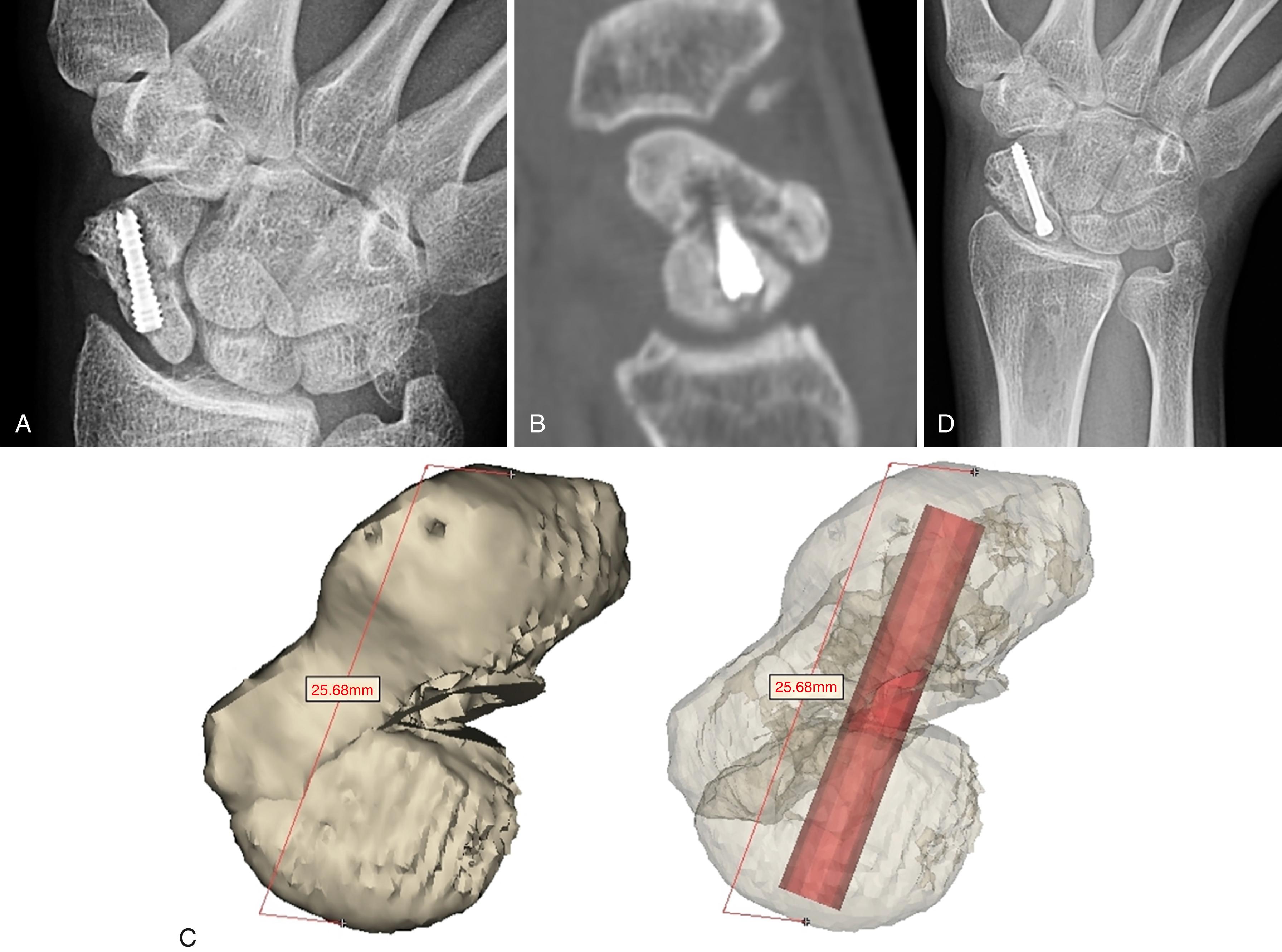
4D CT (3D CT and time) scanning requires continuous data acquisition at a fixed table position using dual source scan mode. It allows for high spatial and resolution of images of the wrist in motion and as such has been used to study carpal instabilities. The ability to do this noninvasively may allow for the detection and location of ligament injuries and help guide selective surgical treatments ( ![]() ). Although promising, this technology needs to be used with caution owing to the higher dose of radiation involved.
). Although promising, this technology needs to be used with caution owing to the higher dose of radiation involved.
Historically, MRI without dedicated wrist coils demonstrated reduced sensitivity and specificity in the diagnosis of SL ligament injury compared with arthroscopy. With state-of-the-art technology and scanning algorithms, MRI’s exceptional soft tissue contrast and direct multiplanar acquisition have enabled an accurate, noninvasive, and reproducible means to evaluate the articular cartilage, injury to the intrinsic and extrinsic ligaments of the wrist, and the TFCC without ionizing radiation ( Fig. 13.21A and B). Properly executed high-resolution MRI using 1 mm contiguous slices, cartilage-sensitive pulse sequence parameters, and dedicated wrist coils may provide complementary information on interosseous and extrinsic ligament injury to wrist arthroscopy. Gadolinium enhancement does not improve diagnostic accuracy for cartilage and ligament assessment and converts noninvasive imaging to a more invasive procedure. While good accuracy has been described with appropriate protocols at 1.5 T systems, 3T studies provide higher signal-to-noise ratios and allow for potentially shorter acquisition times. Ultrahigh field (7T) MRI may provide increased spatial resolution of the wrist, but is currently limited by the lack of available wrist coils and greater artifact generation.
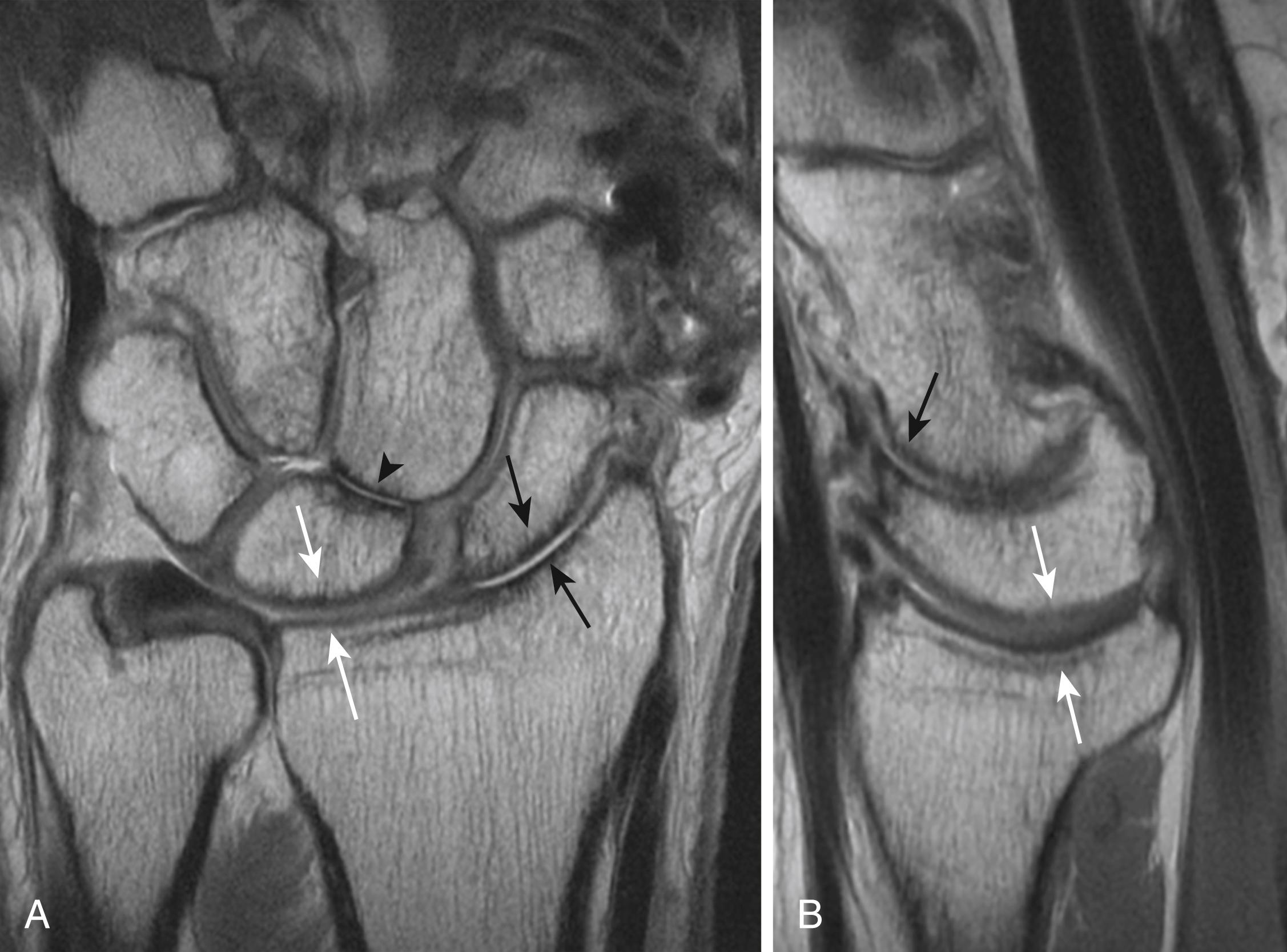
Together with 4D CT imaging of the wrist, real-time dynamic 3D MRI has been investigated for the assessment of dynamic carpal instabilities. Rather than replacing high spatial resolution static scans, it may be used as an adjunct given its lower in-plane spatial resolution.
High-resolution ultrasound (US) has demonstrated increasing utility in the assessment of both intrinsic and extrinsic wrist ligaments. High-frequency linear transducers have been shown to have great potential. Ultrasonography is considerably less expensive than MRI and is real time (permitting dynamic evaluation of kinematic instabilities). With the advent of dynamic and Doppler ultrasonography, this modality may be incorporated into clinical practice as an inexpensive and safe method to get most of the information required to make accurate treatment decisions.
Wrist arthroscopy provides the technical capabilities to examine and treat articular abnormalities without an arthrotomy. In conjunction with a detailed history and physical examination, arthroscopy provides an exceptional evaluation of the articular surfaces, synovial tissues, intercarpal ligaments, and the critical supporting ligaments of the proximal carpal row. Arthroscopy is a useful adjunct in the management of various acute and chronic wrist lesions, and its indications are detailed throughout this chapter and reviewed in detail in Chapter 17 .
When carpal instability is caused by disease or injury resulting in a disruption between bones of the same row, it is classified as CID. Dissociative instabilities are common and may result from a variety of conditions, including SLDs, LT dissociations, unstable scaphoid fractures, nonunions, malunions, inflammatory synovitis, and advanced Kienböck disease.
SLD is the most frequent carpal instability , and can appear either as an isolated injury or in association with other local injuries (e.g., distal radial fractures, perilunate injuries, displaced scaphoid fractures, or inflammatory arthritis).
A fall on the outstretched hand with the wrist in extension, ulnar deviation, and intercarpal supination may cause a wide spectrum of injuries, from minor SL sprains to complete perilunate dislocations. Although differing in severity and prognosis, these clinical conditions are stages of the same progressive perilunate destabilization process described earlier.
The kinematic and kinetic consequences of SL ligament injury have been investigated by many authors. , In cadaveric studies, if only the palmar SL ligament and the proximal membrane are ruptured, minor kinematic alterations may occur in scaphoid flexion or lunate extension during wrist motion. , These partial injuries are theorized to result in “dynamic” or “occult” instability. There is no diastasis of the SL interval, no resting postural changes of the carpus, but patients may be intermittently symptomatic under heavy mechanical load.
Complete sectioning of the SL (palmar, membranous, and dorsal) ligaments results in more substantial alterations of wrist kinematics and force transmission parameters, but acutely does not result in SL diastasis or carpal malalignment. , Immediate carpal postural changes occur only if there is concomitant rupture of one or more of the critical ligament stabilizers of the proximal carpal row; that is, the radiopalmar STT ligament complex, one or both components of the dorsal intercarpal ligament, or the long RL ligament. , Even when not acutely ruptured, it is theorized that these same ligaments may gradually attenuate with loading over time, allowing secondary rotatory and dorsal subluxation of the scaphoid, dorsal tilt of the intercalated segment (DISI), and, ultimately, carpal collapse. Kauer believed that the unconstrained lunate has a natural tendency toward displacing into extension owing to its shape, but also due to the fact that it articulates with a radial surface that is volarly inclined. Without its proximal tether to the lunate, and under the flexion loads of the radial column, the scaphoid flexes around the RSC ligament, while pronating and translocating dorsally and radially. , Without the joint reaction force of the proximal scaphoid, and with slackening or attenuation of the long RL or the DIC or both, the triquetrum and lunate rotate dorsally under the extension moment of the hamate’s articular surface. As a result of the scaphoid collapsing into flexion and pronation and the lunate and triquetrum into extension, the distal row translates dorsally and rotates into pronation (see Fig. 13.14 ).
With SLD, the forces crossing the wrist are not distributed normally. An increased compressive and shear stress appears on the dorsal and lateral aspect of the RS articulation as the proximal pole of the scaphoid subluxates dorsoradially with wrist flexion and during manual load, ultimately leading to cartilage loss and osteoarthritis. The lunate extends but its kinetics remain stable because the lunate and the lunate facet of the radius are perfectly congruent. This explains why the RL articular cartilage is spared until very late in the degenerative process. There is considerable variability in the progression of SLD and degeneration following complete SLIL rupture. O’Meeghan et al. reported on the natural history of arthroscopically proven SL rupture without either SL widening or DISI on x-ray and found that at an average of 7 years, all 11 patients had functional sequelae and wrist pain, but none went on to develop SLAC changes.
Watson and associates coined the term scaphoid-lunate advanced collapse to define a three-stage progression of degenerative changes secondary to SLD. In the earliest stage, only the distal radial styloid-scaphoid articular surface degenerates, with characteristic breaking of the styloid tip. In stage II, progressive loss of the proximal scaphoid articular cartilage and the dorsal scaphoid fossa ensues under the shear forces described above. In stage III, the midcarpal joint degenerates. Whether the RL joint undergoes progressive degeneration is controversial, though often the dorsal lip of the RL fossa narrows appreciably.
A history of a fall on an outstretched hand should warn the clinician about the potential for a SL injury, sometimes masked by a fracture of the scaphoid or distal radius. SLD is frequently missed at presentation, especially in isolated partial lesions, or when it is masked by other, more obvious injuries. When SLD is static or results from a perilunate dislocation, the diagnosis is generally more obvious. According to Geissler, up to 30% of distal radial fractures are associated with variable degrees of carpal ligament disruption. Aside from wrist trauma, iatrogenic SL injury can occur with excessive capsular excision that disrupts dorsal ligaments when removing ganglions or after ligament attenuation from inflammatory, crystalline, or septic arthritis. Although SLD is rare in children, diagnosis is more problematic because it is not easy to clearly identify bony alignment in an immature skeleton, and performing a clinical examination is difficult.
In both children and adults, a high index of suspicion is needed to avoid missing this injury. The symptoms of SLD vary markedly depending on the magnitude of the ligament rupture, the extent of associated injuries, and elapsed time since injury. Poor grip strength, limited mobility, dorsoradial swelling, and point tenderness over the dorsal aspect of the SL interval are the most common findings. , Pain is common and is usually aggravated by intense use of the hand. The patient may report a clunking sensation during wrist movement due to dislocation or reduction of a dorsally subluxated proximal scaphoid.
On inspection, there may be minimal or no changes in the appearance of the wrist with SL instability. Even in the acute phase, swelling and ecchymosis may be moderate. Palpation at the areas of maximal tenderness is useful in the diagnosis of wrist pathology, especially for patients with chronic SL instability. By flexing the wrist and palpating the dorsum of the capsule distal to the Lister tubercle, one can obtain important information about the SL joint. If sharp pain is elicited by pressing this area, the probability of either a recent injury or a chronic localized synovitis is high. Most of these patients also have tenderness in the anatomic snuffbox and over the palmar scaphoid tuberosity. In acute cases, ROM is usually limited by pain, whereas it may be normal in chronic cases.
Passive mobilization of an unstable SL joint is valuable not only in determining the presence of abnormal scaphoid subluxation but also in reproducing the patient’s pain. A positive scaphoid shift test, as described by Watson and colleagues (painful reproduction of the patient’s scaphoid subluxation), is said to be diagnostic of SLD. The examiner places four fingers behind the radius, and the thumb on the scaphoid tuberosity (distal pole). The other hand is used to move the wrist passively from ulnar to radial deviation. In ulnar deviation, the scaphoid is extended and assumes a position more in line with the forearm. In radial deviation, the scaphoid is flexed. Pressure on the tuberosity while the wrist is moved from ulnar to radial inclination prevents the scaphoid from flexing. If the SL ligaments are completely ruptured or elongated, the proximal pole subluxates dorsally out of the radius, inducing pain in the dorsoradial aspect of the wrist ( Fig. 13.22 ). When pressure is released, a typical clunk may occur, indicating reduction of the scaphoid into the scaphoid fossa of the radius.
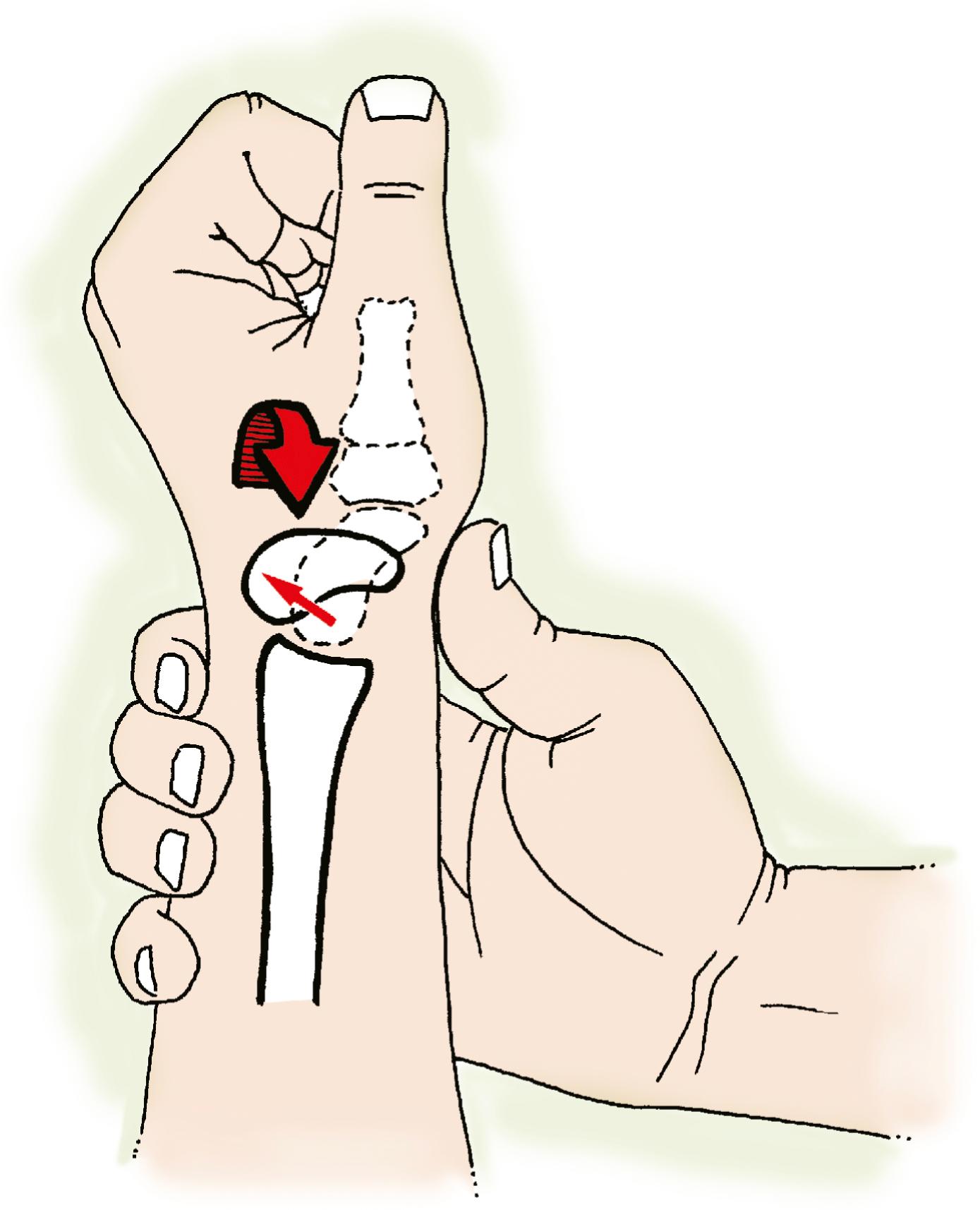
When performing the scaphoid shift test, one should be aware of its low specificity. If the SL ligaments are intact, but there are other pathologies inducing a local synovitis (e.g., occult ganglion or dorsal RS impingement), this test may also provoke sharp pain, making it difficult to discern whether there is an abnormally unstable proximal scaphoid. Additionally, patients with generalized laxity may exhibit painless clunks during this maneuver, which most likely emanate from the LC joint. Comparison of the two sides is important, although sometimes the opposite “asymptomatic” wrist has a painful scaphoid shift test as well. , Experience with this test is necessary before it can be interpreted with confidence, and repeating this test under fluoroscopy in equivocal cases can be revealing.
The lunate is firmly stabilized with the thumb and index finger of one hand, while the scaphoid, held with the other hand (i.e., thumb on the palmar tuberosity and index on the dorsal proximal pole) is displaced dorsally and palmarly. The test is positive when there is pain, crepitus, and excessive mobility of the scaphoid. This is a variation of the scaphoid shift maneuver and has also been called the scaphoid thrust test.
On standard radiographs, SLIL injury is suspected in the presence of a widened SL gap, dorsal tilt of the lunate, or increased scaphoid flexion. Dynamic instabilities require special projections or loading conditions for these features to be observed. Radiographic findings should always be compared with the asymptomatic side.
The “Terry Thomas sign,” named by Frankel after the English film comedian’s dental diastema, , is considered positive when the space between the scaphoid and lunate appears abnormally wide compared with the contralateral side ( Fig. 13.23 ). The SL gap should be measured in the middle of the flat ulnar facet of the scaphoid. A unilateral gap greater than 5 mm is diagnostic of SLD. If there is no history of a specific traumatic episode, and yet there is an obvious SL diastasis, one must consider either a constitutionally increased SL gap, which is usually bilateral, with or without hyperlaxity. Other less common causes of bilateral SL diastasis include rheumatoid arthritis, gout, and calcium pyrophosphate deposition disease. To rule out the presence of an asymptomatic SL ligament injury, dynamic stress views or advanced imaging is critical.
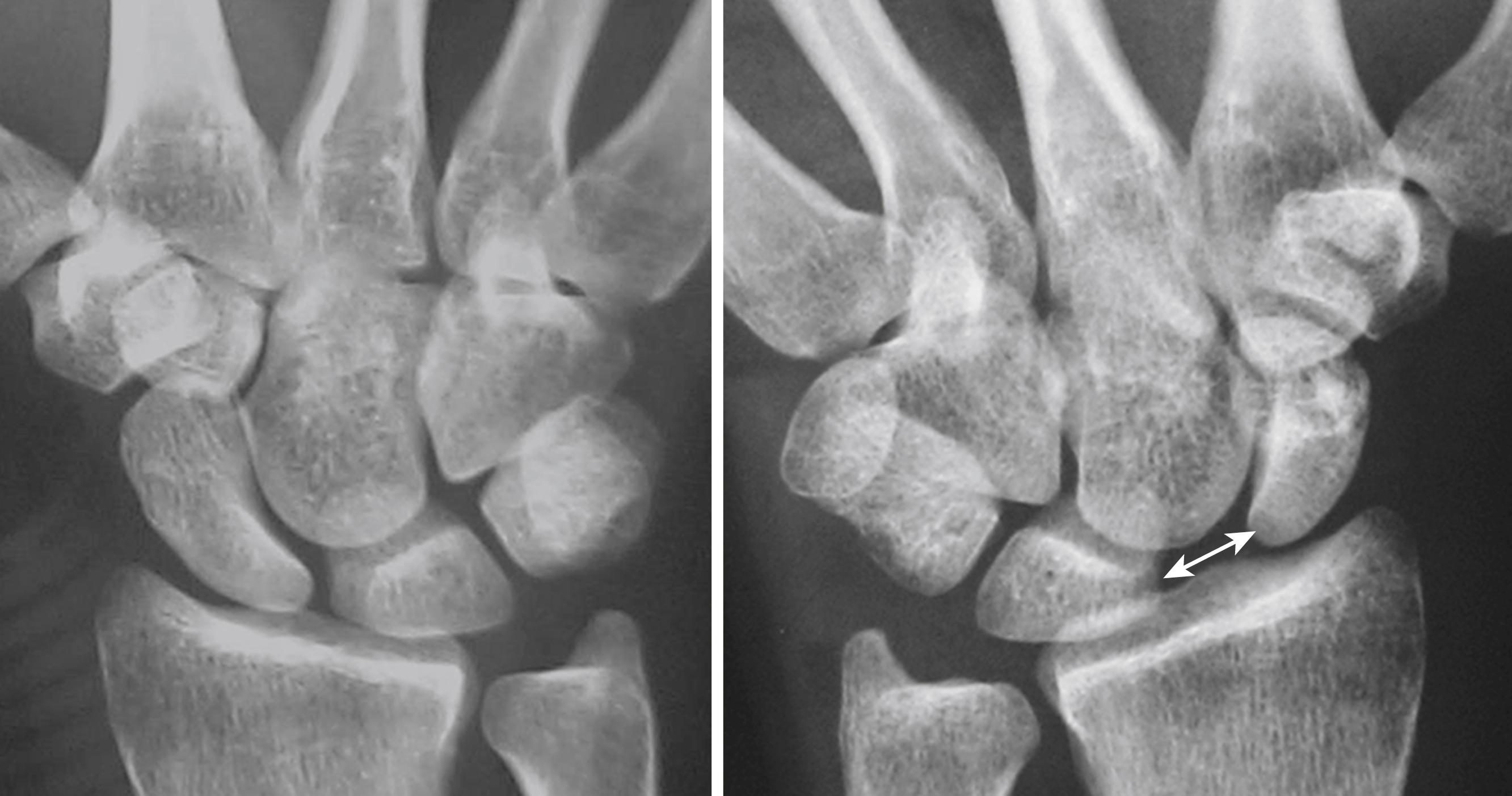
When the scaphoid has rotated into flexion and pronation, it has a foreshortened appearance in the PA view. In such circumstances, the scaphoid tuberosity is shown in the PA projection in the form of a radiodense circle or ring over the distal two-thirds of the scaphoid ( Fig. 13.24 ). This is the “ring sign” and is present in all cases where the scaphoid is abnormally flexed, regardless of the cause. The presence of this sign does not always indicate SLD, as this can also occur in a dissociative or nondissociative VISI deformity.
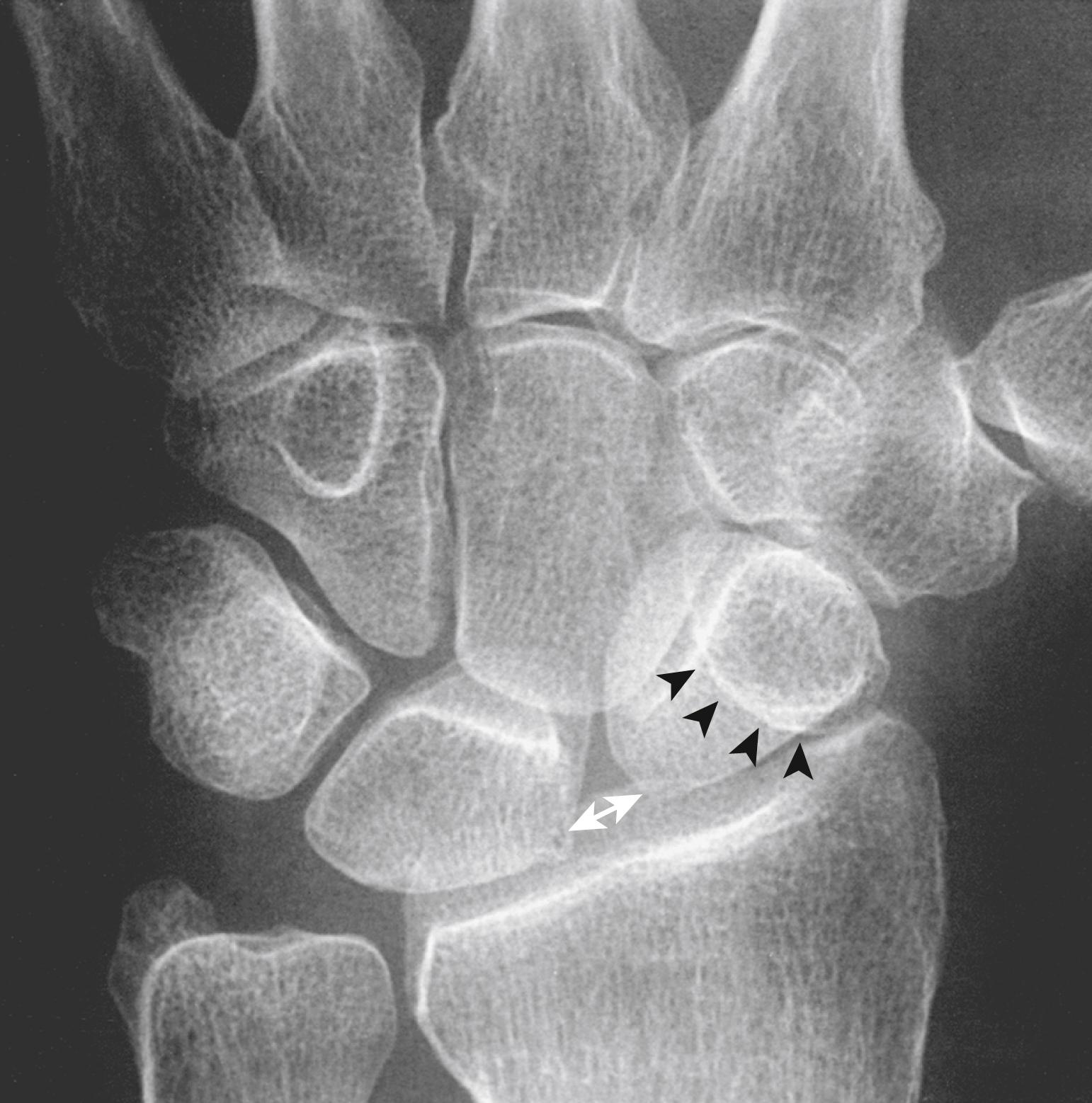
In the lateral view, if the scaphoid lies more perpendicular to the long axis of the radius than the contralateral side (>60 degrees) and the lunate appears normally aligned or extended, SLD should be suspected ( Fig. 13.25A ). This angle will progressively increase as the lunate extends to accommodate the loss of height of the radial column, causing a dorsal subluxation of the capitate.
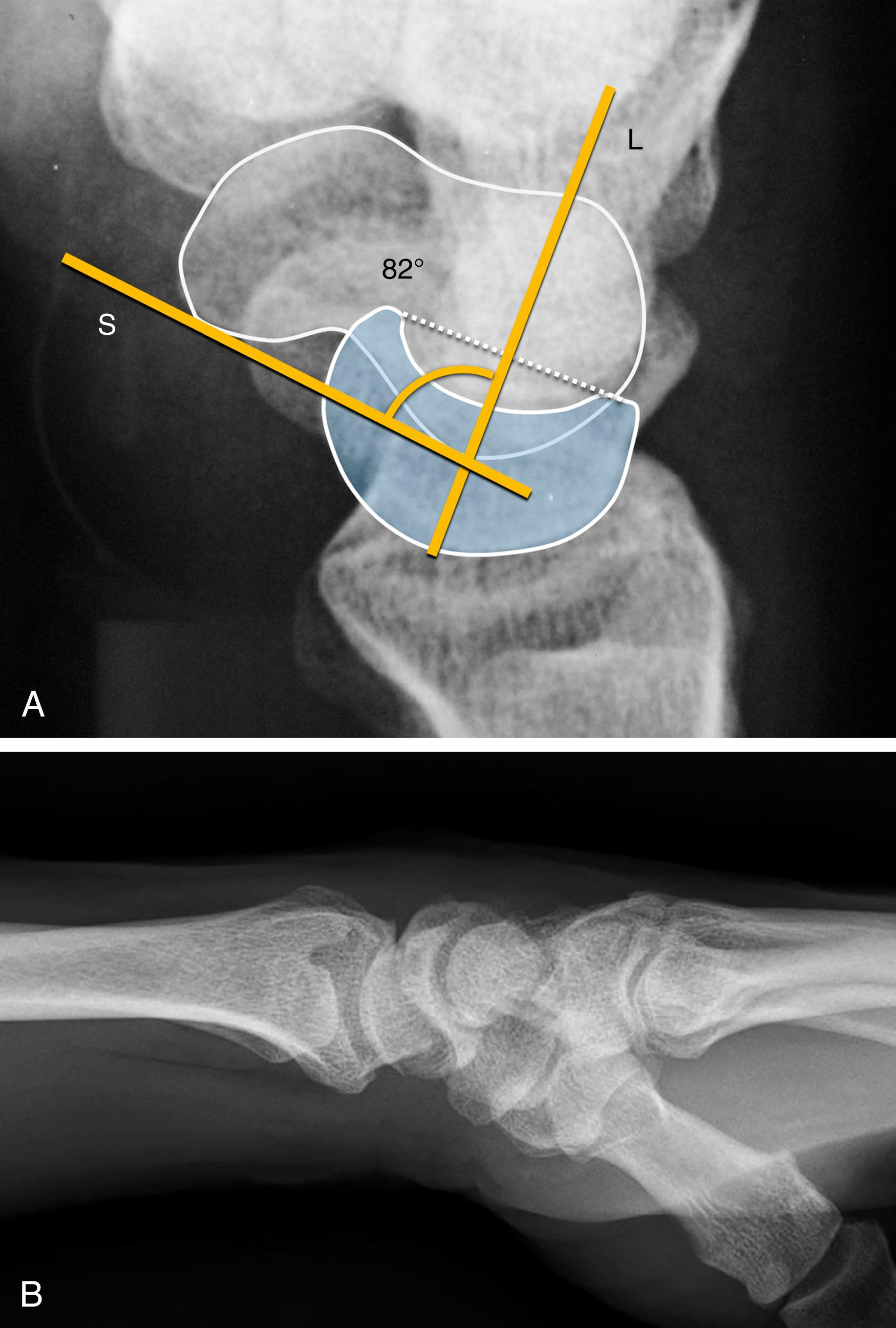
Translation of the proximal scaphoid onto the dorsal rim of the distal radius may be seen in advanced SL instability and is best visualized on the lateral radiograph (see Fig. 13.25B ). This can be subtle but is readily detected using the dorsal tangential line technique.
While history, clinical examination, and radiographs are often diagnostic, other imaging modalities may be useful to better understand chronicity, kinematics, cartilage health, and potential concomitant injury.
Dynamic fluoroscopy not only shows abnormal motion between the scaphoid and lunate but also changes in the kinematics of the midcarpal joint. For example, the triquetrum-hamate relationship normally changes from full engagement in ulnar deviation to complete disengagement in radial deviation; in SLD patients with DISI, this joint remains permanently engaged. In addition, live imaging shows whether the DISI is reducible, giving the physician valuable information as treatment is being planned.
CT scanning enables the 3D analysis of carpal dysfunction. By adding motion in real time (4D CT), this may hold promise in the future to potentially quantify the location and degree of injury noninvasively and help surgeons plan their surgical treatment surgeon can direct their treatment (see ![]() ).
).
A properly performed, high-resolution MRI aids in the evaluation of ligament injuries of the wrist. A static magnetic field strength of at least 1.5 T using a dedicated wrist coil is recommended for analyzing the interosseous, intrinsic, and extrinsic ligament insertions ( Fig. 13.26A–C ). Higher magnetic field strengths result in a higher signal-to-noise ratio with shorter scan times. The volar extrinsic, SL interosseous, dorsal intercarpal, and LT ligaments are best visualized using 1 mm slices (with no interslice gap) in the coronal plane. The DRC and intercarpal ligaments are best viewed on both the coronal and sagittal images (see Fig. 13.26D ). Oblique axial views along the longitudinal axes of these ligaments allow further analysis, especially when an injury is suspected. Concomitant cartilage-sensitive imaging is imperative to complement the assessment of ligaments, as the cartilage integrity will influence the clinical/surgical management, especially in the setting of SLAC wrist (see Fig. 13.21 ). Real-time MRI has been used to investigate dynamic instabilities, although its routine use in clinical practice is yet to be further determined.
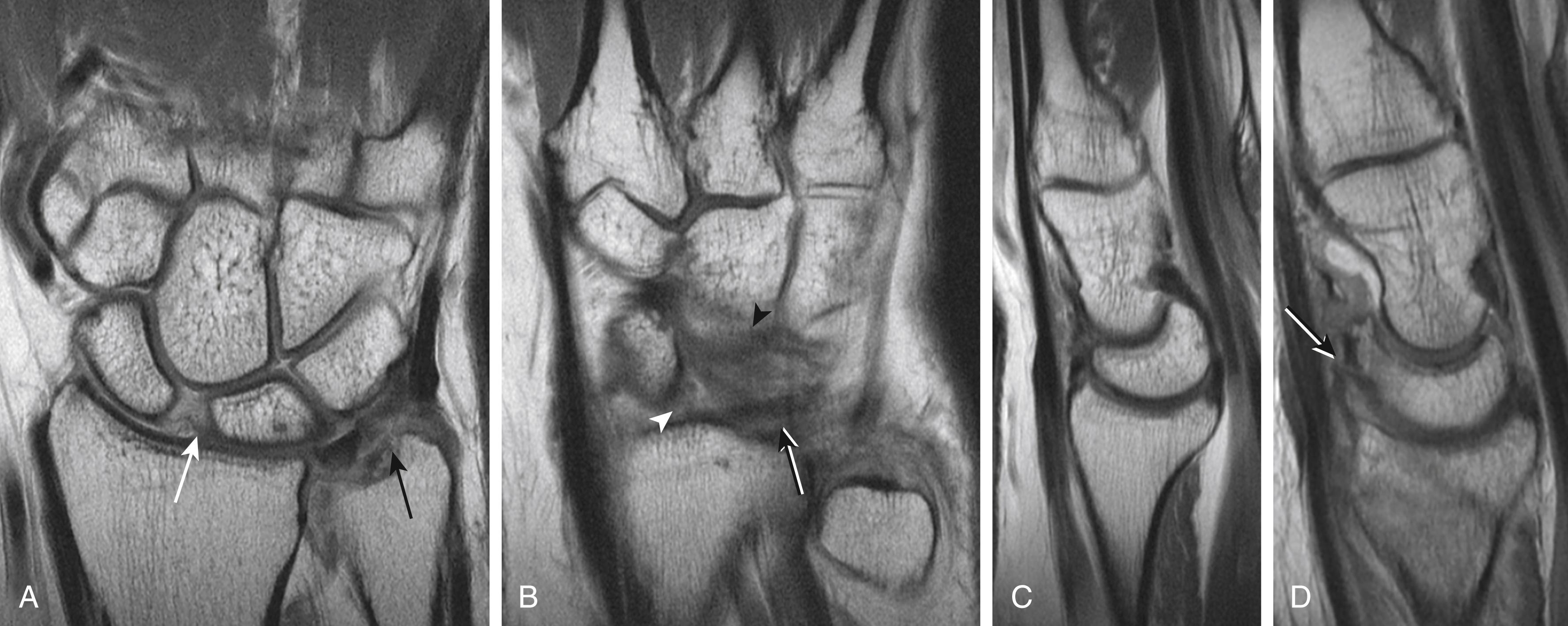
Arthroscopy is considered by many to be the diagnostic intervention of choice for determining the degree of injury to the wrist and can assess the condition of the cartilage (normal or degenerative), ability to reduce the carpus and any other associated injuries. In addition, the degree of intrinsic and extrinsic ligament injury can be identified from the arthroscopic evaluation; Lee et al. demonstrated that Geissler grade II SLIL injuries tend to be isolated, whereas grade IV injuries often involve complete dorsal extrinsic ligament disruption. This information can be used to determine surgical treatment for SL and LT interosseous ligament injuries. (See also Chapter 17 .)
Given the myriad of factors that need to be considered in the treatment of SL ligament injury, the outcome is not always predictable. , , , When the initial injury is a partial SL ligament disruption, radiographs are usually normal, and the injury is frequently missed at presentation. Even if diagnosed early, the ligament remnants may be short and difficult to repair. Given that the SL ligament is exposed to considerable tension and torsion, it is not unusual for repairs to deteriorate with time. There is thus no guarantee that a repaired SL ligament will retain good functional strength and adequate stabilizing capability, even with early diagnosis and proper treatment. Importantly, the critical extrinsic and intrinsic ligament stabilizers may have been damaged at the time of injury, and while structurally present, may not be functionally competent.
More commonly, SLD is discovered in the subacute or chronic phase, when carpal malalignment is evident on plain radiographs. Even if not injured initially, abnormal SL kinematics induced by SLIL disruption may gradually attenuate the critical ligamentous stabilizers under load. Once carpal postural changes are evident on static films, the underlying pathology no longer involves a single structure but consists of a complex, multilevel ligament injury. Some ligament remnants are disrupted, whereas others are attenuated and/or insufficient to stabilize the joint. Furthermore, if substantial time has elapsed since the initial injury, cartilage degeneration may have set in, making an acceptable outcome from ligament repair less likely. , ,
For these reasons, treating the injury in the acute phase, when the healing potential is greatest, is generally more successful than trying to reverse chronic or degenerative injuries. It is important to carefully consider the patient’s age, occupation, recreational demands, and level of symptoms prior to embarking on a treatment plan. To facilitate patient selection and appropriate treatment, Garcia-Elias , , developed an algorithm for the treatment of SLD (see Critical Points).
Is the dSLIL intact and functional?
If the ligament has ruptured, does it have good integrity for repair?
Is the scaphoid alignment normal?
Is RL alignment still retained?
Are abnormal carpal alignments easily reducible?
Is the articular cartilage normal?
The answers to the Critical Points questions enable categorization of the SLD into seven stages ( Table 13.4 ). An increased number of negative answers indicates progression from a minor problem (stage 1) to a global dysfunction (stage 7). Treatment must be tailored to the specifics of each case, and importantly, to the patient’s needs. The following subsections describe all the stages in turn, including the most commonly used treatment for each.
| Stage 1 | Stage 2 | Stage 3 | Stage 4 | Stage 5 | Stage 6 | Stage 7 | |
|---|---|---|---|---|---|---|---|
| Partial injury | Yes | No | No | No | No | No | No |
| Repairable | Yes | Yes | No | No | No | No | No |
| Normal RS angle | Yes | Yes | Yes | No | No | No | No |
| Lunate aligned | Yes | Yes | Yes | Yes | No | No | No |
| Reducible | Yes | Yes | Yes | Yes | Yes | No | No |
| Normal cartilage | Yes | Yes | Yes | Yes | Yes | Yes | No |
Become a Clinical Tree membership for Full access and enjoy Unlimited articles
If you are a member. Log in here